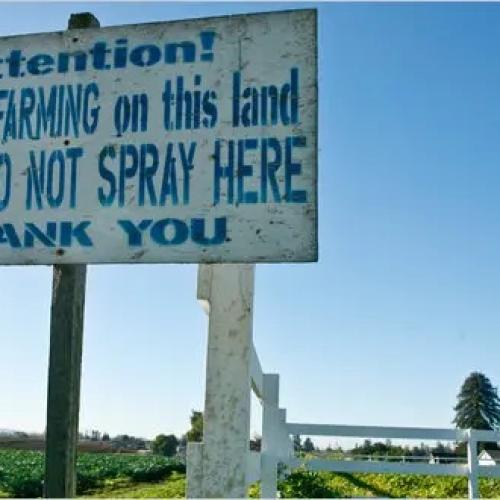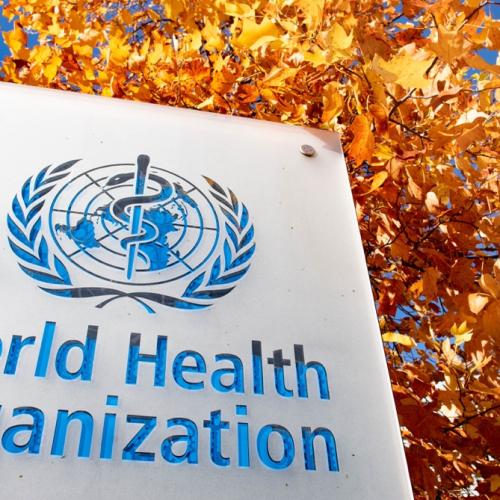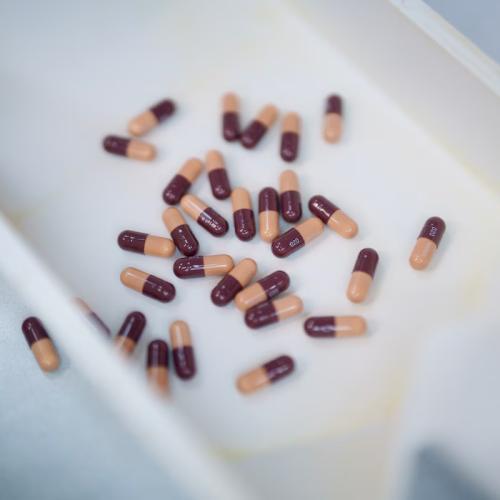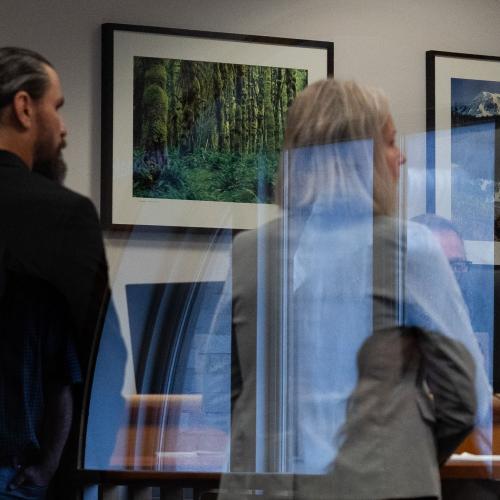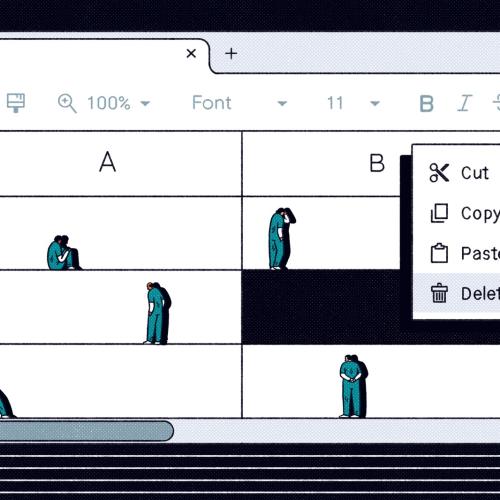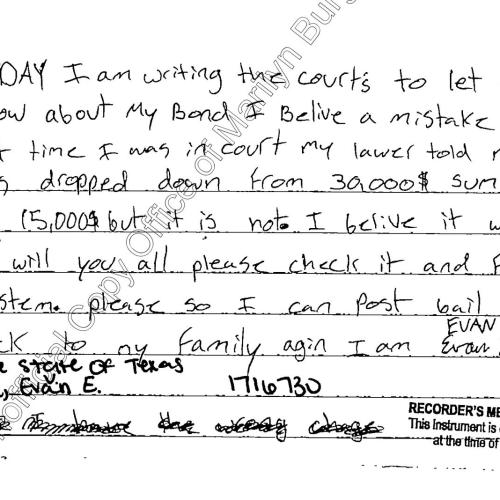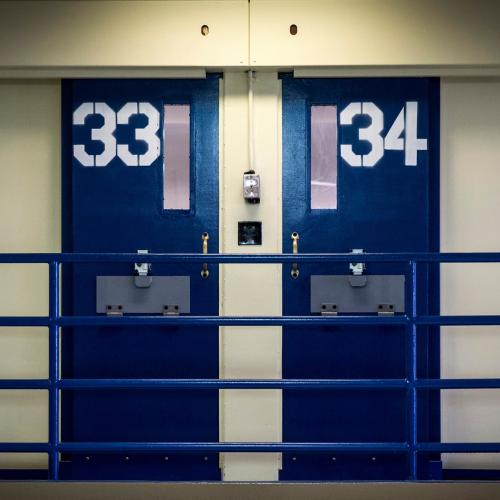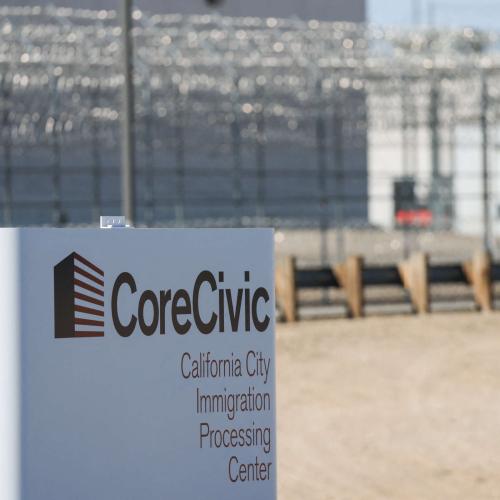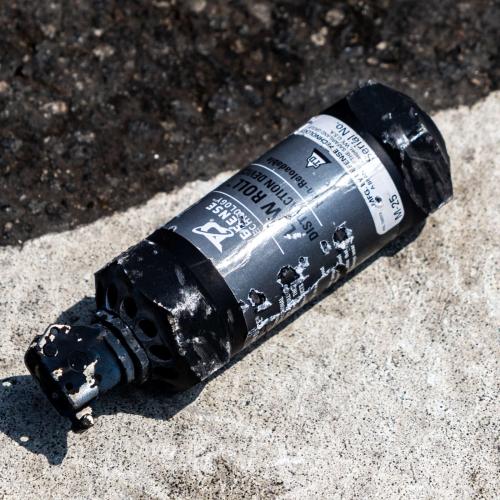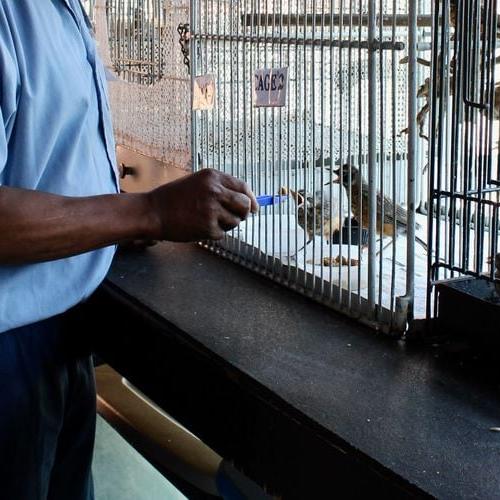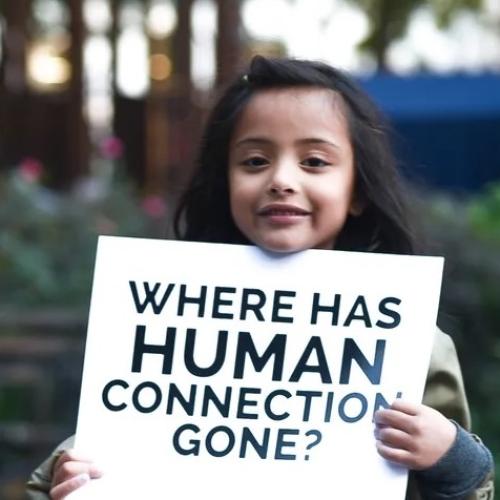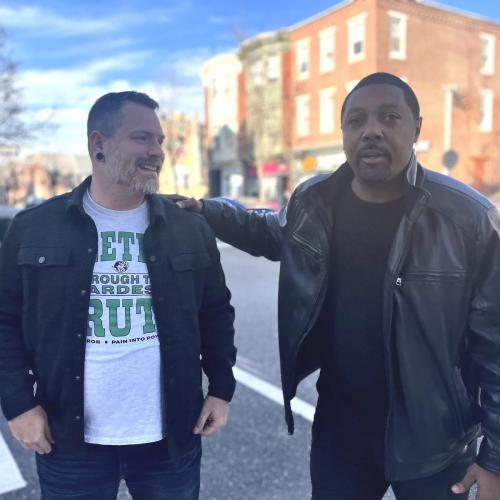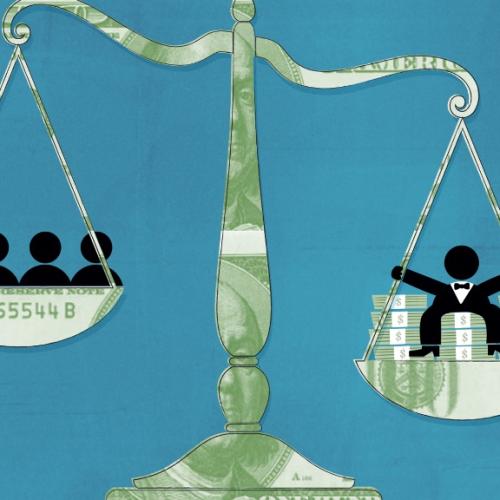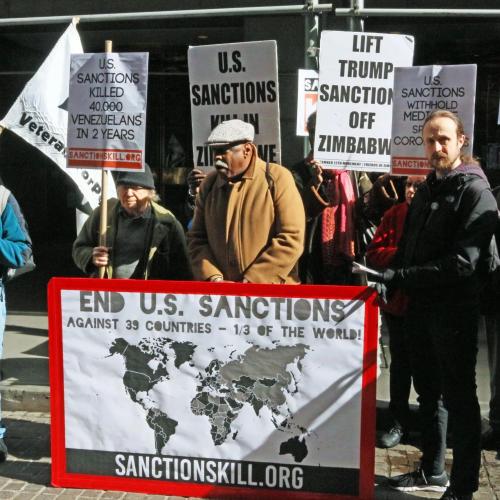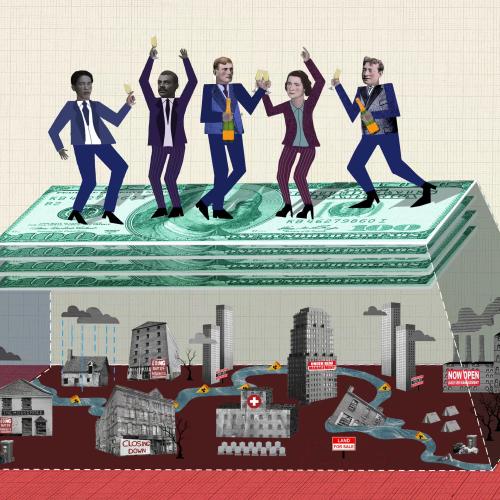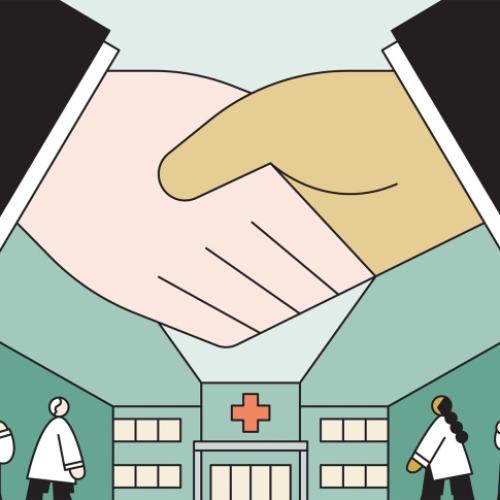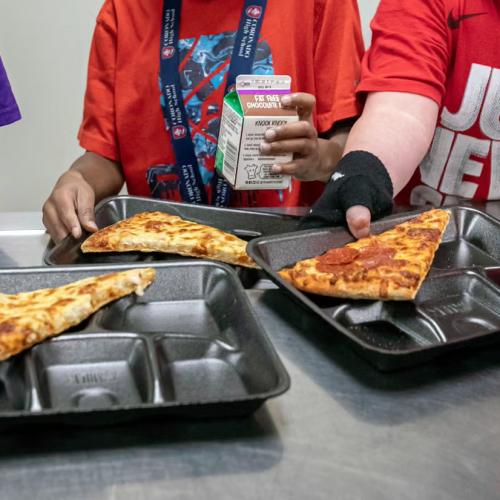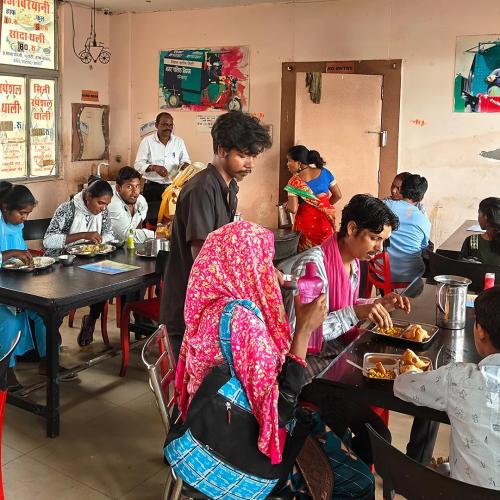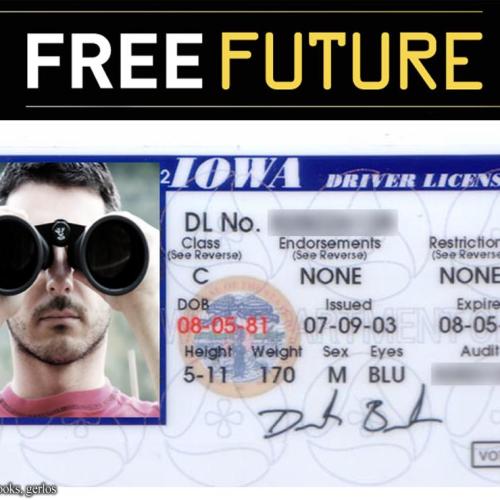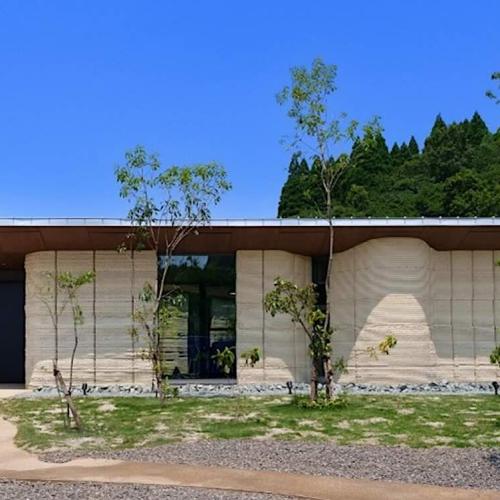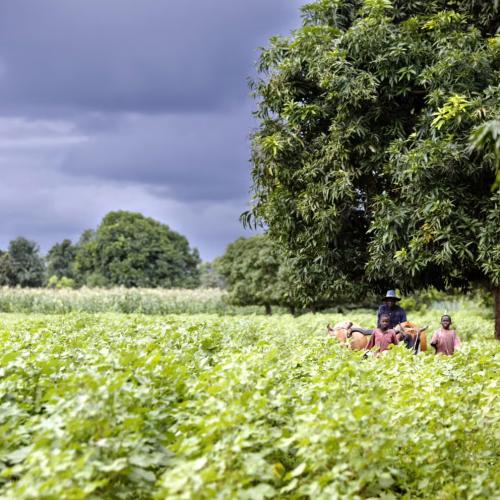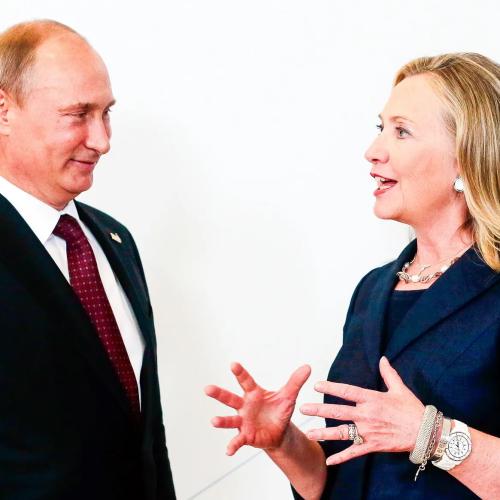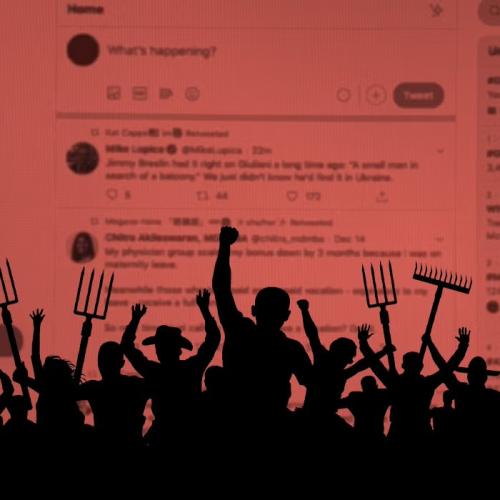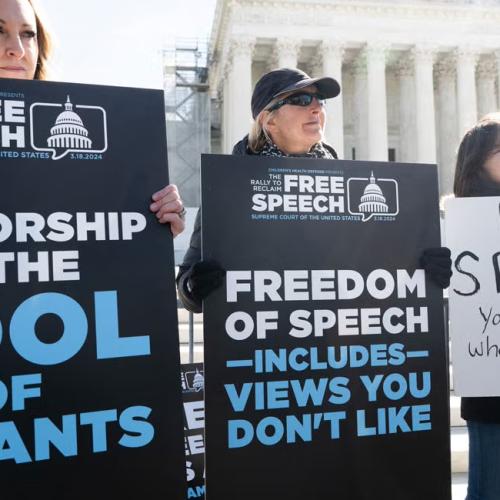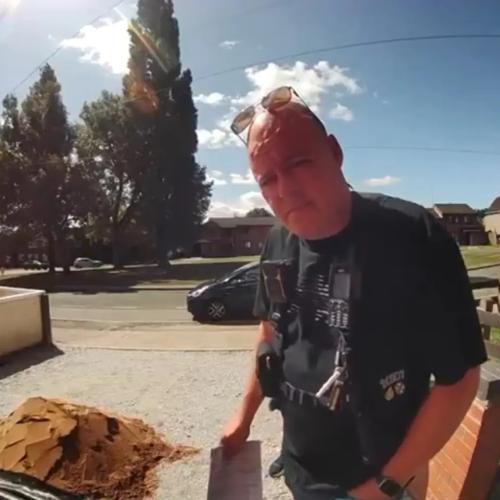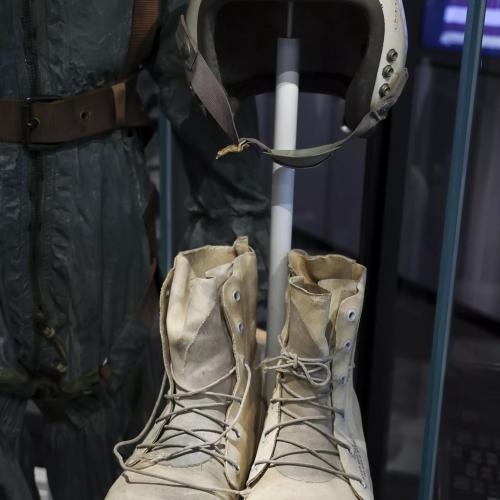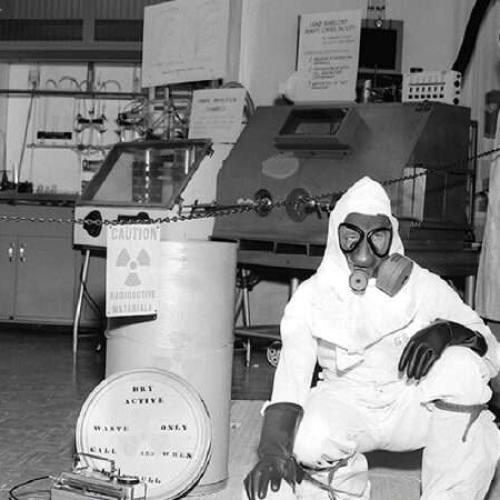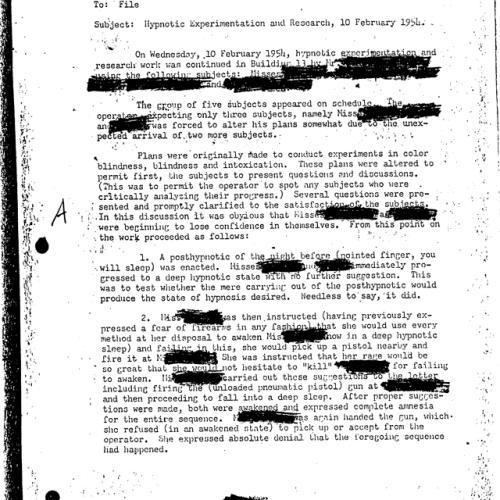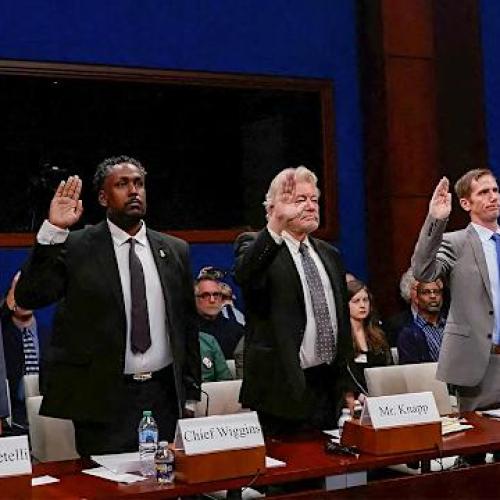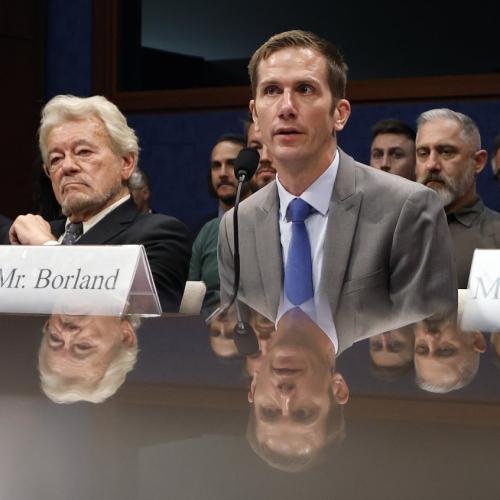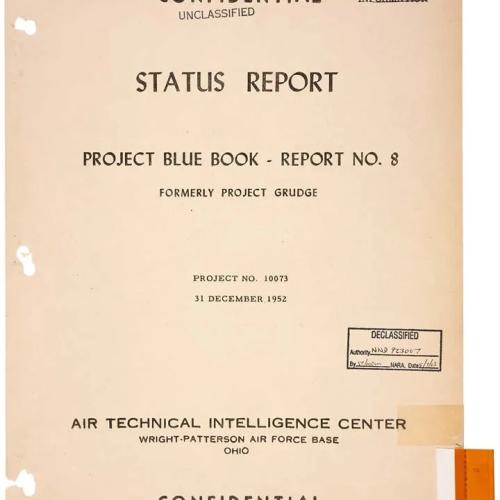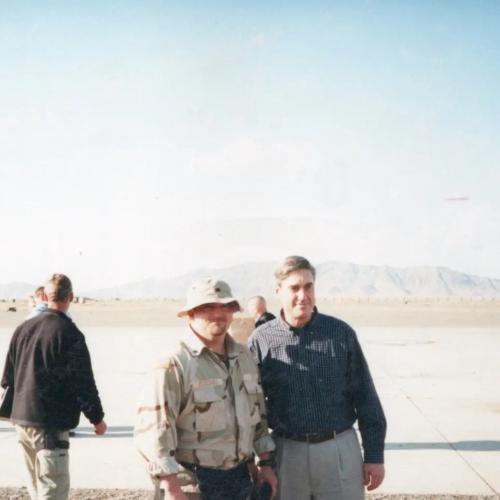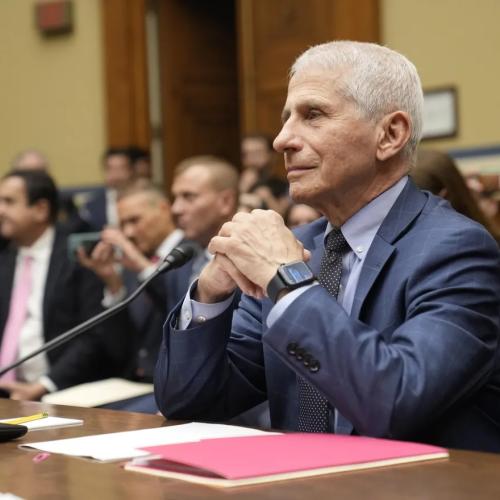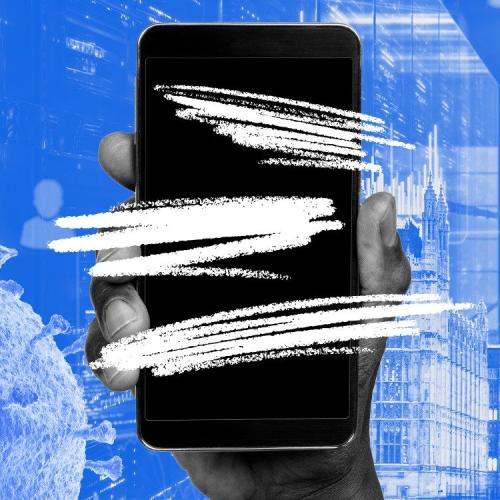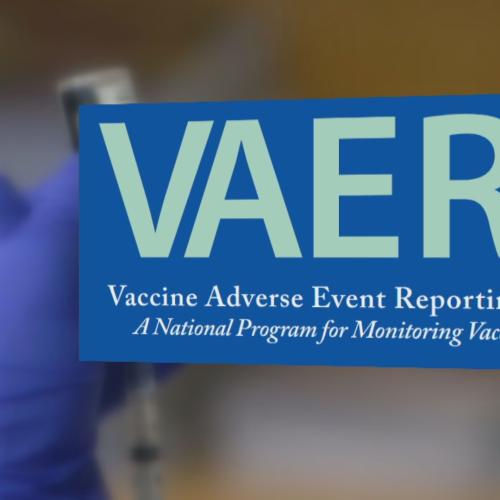Inspiring: Reimagining the Economy News Articles
Below are key excerpts of inspiring news articles on reimagining the economy from reliable news media sources. If any link fails to function, a paywall blocks full access, or the article is no longer available, try these digital tools.
For further exploration, delve into our Inspiration Center.
Consider the Norwegians, who experienced extreme polarization at the same time as the Germans did. The Norwegian economic elite organized against striking laborers and produced a polarized country that included both Nazi Brown Shirts goose-stepping in the streets and Norwegian Communists agitating to overthrow capitalism. The politician Vidkun Quisling, an admirer of Hitler, organized in 1933 a Nazi party, and its uniformed paramilitary wing sought to provoke violent clashes with leftist students. Quisling reportedly held discussions with military officers about a possible coup d’etat.The stage was set for a fascist “solution.” Instead, Norway broke through to a social democracy. Progressive movements of farmers and workers, joined by middle-class allies, launched nonviolent direct action campaigns that made the country increasingly ungovernable by the economic elite. The majority forced the economic elite to take a back seat and invented a new economy with arguably the most equality, individual freedom, and shared abundance the developed world has known. The key to avoiding fascism? An organized left with a strong vision and broad support. Grassroots movements built a large infrastructure of co-ops that showed their competency and positivity when the government and political conservatives lacked both. Additionally, activists reached beyond the choir, inviting participation from people who initially feared making large changes. Norwegians also ... chose nonviolent direct action campaigns consisting of strikes, boycotts, demonstrations, and occupations. Norway therefore lacked the dangerous chaos that in Germany led the middle classes to accept the elite’s choice of Hitler to bring “law and order.”
Note: Explore more positive stories like this about healing social division and reimagining the economy.
Time banks offer an alternative, powered by 21st-century technology, to the U.S. dollar. About 70 exist across the country — some with a few members, others with hundreds — to give value to work that members say often goes uncompensated in a traditional market economy. The Silver Spring Time Bank formed in 2015 and has about 300 members, said co-founder Mary Murphy. Last year, she said, 1,000 hours were exchanged for basic home repairs, dog walking, cooking and tailoring, among other services, without the exchange of money. “You get to save that money that you would have spent,” she said. “You get to meet somebody else in your community and get to know that person. That's a bonus.” Edgar S. Cahn, an 84-year-old law professor who had worked on civil rights and anti-poverty legislation in president Lyndon B. Johnson’s Justice Department, suffered a heart attack in 1980. He said doctors gave him two years to live, with “maybe two good hours a day. I thought: What do I do with two good hours a day?” he said, having beaten doctors’ expectations by nearly four decades. “I have to teach people to value themselves ... We’re all trained as human service professionals: 'How can I help you?'' ” he said. “None of us is trained to say: ‘How can you make a difference?’ I need you as much as you need me.” Cahn became a proselytizer for what he called the “time dollar” — a currency in which an hour of work is worth an hour of work, whether it’s performed by a maid, a mechanic or a mechanical engineer. In 1995, he founded the D.C. nonprofit TimeBanks USA, which developed the software used by many time banks around the world. Time banks can serve as small-business incubators and a way for seniors to remain active after retirement.
Note: Read more about the potential of time banking. Explore more positive stories like this in on reimagining the economy.
Finland's high levels of social trust could be one reason the country has been ranked as the world's happiest for six years in a row. As the World Happiness Report, which does the ranking, notes, most Finns expect their wallet to be returned to them if they lose it. Finns have liberated children, trust their neighbors, commune with nature, and leave work on time. But ask them what they think of the happiness report, and you'll get a surprising answer. "We're always surprised that we are still the first," Meri Larivaara, a mental-health advocate, told me in [a] Helsinki coffee shop. "Every year there is a debate like, 'How is this possible?'" In fact, locals I talked to were exasperated by the survey and even annoyed by the global perception of them as happy. Finnish people are often stereotyped as introverted and keeping to themselves. But it's also true that Finns are very content with what they have. "They call us up and just ask if we like our lives. We just say there's nothing wrong right now, maybe call back tomorrow," one local said of the survey. Maybe it's not so much that Finns are happy but that they don't have some of the intense fears you might find in other places. Finland's government sponsors one of the most robust welfare systems in the world. In 2021, the Nordic country spent 24% of its gross domestic product on social protection — the highest of any other OECD country that year. Healthcare and education are free for all residents — all the way through to the Ph.D. level.
Note: Explore more positive stories like this in our comprehensive inspiring news articles archive focused on solutions and bridging divides.
Public banks are typically operated by government or tribal authorities and, in theory, would be chartered to achieve social good and invest in communities. Only two public banks currently operate in the United States: the Bank of North Dakota, founded in 1919, and the Territorial Bank of American Samoa, founded in 2018. Organizations pushing for a public banking option exist in 37 states, according to the Public Banking Institute. In contrast to private banks, which are responsible to their shareholders, public banks are responsible to their boards and are chartered to invest in public needs. The Bank of North Dakota, for instance, is chartered to offer a “revolving loan fund” to farmers, and profits from loans are directed back into the fund to keep interest rates low. The modern movement to invest in public banks grew out of the 2008 financial crisis and was galvanized during the pandemic, fueled by a populist distrust of the banking and finance sectors. In October 2020, Representatives Alexandria Ocasio-Cortez and Rashida Tlaib introduced the federal Public Banking Act, which would allow state and local governments across the country to create public banks. In the first two months of 2021 there were sixteen bills across the country designed to pave the way for public banks. Supporters of public banks are hoping that any deposits from state and local governments can be used to fund community-based projects that have trouble getting funded by private banks.
Note: Explore more positive stories like this in our comprehensive inspiring news articles archive focused on solutions and bridging divides.
A time bank does with time what other banks do with money: It stores and trades it. “Time banking means that for every hour you give to your community, you receive an hour credit,” explains Krista Wyatt, executive director of the DC-based nonprofit TimeBanks.Org, which helps volunteers establish local time banks all over the world. Thousands of time banks with several hundred thousand members have been established in at least 37 countries, including China, Malaysia, Japan, Senegal, Argentina, Brazil and in Europe, with over 3.2 million exchanges. There are probably more than 40,000 members in over 500 time banks in the US. Many time banks are volunteer community projects, but the one in Sebastopol, [CA] is funded by the city. “Every volunteer hour is valued around $29,” Wyatt calculates. “Now think about the thousands of dollars a city saves when hundreds of citizens serve their community for free.” The Sebastopol time bank has banked more than 8,000 hours since its launch in 2016. Five core principles ... guide time banks to this day: First, everyone has something to contribute. Second, valuing volunteering as “work.” Third, reciprocity or a “pay-it-forward” ethos. Fourth, community building, and fifth, mutual accountability and respect. “What captured me is that people are doing things out of their own good heart,” Wyatt says. “Many years ago, a woman ... said to [civil rights lawyer] Edgar Cahn, ‘I have nothing to give.’ Edgar Cahn listened and finally responded, ‘You have love to give.’ And the whole room just went silent.” Every hour of service is valued the same, no matter how much skill and expertise a task takes, whether it’s an hour keeping someone company, helping them file their taxes or repair a roof.
Note: Explore more positive stories like this in our comprehensive inspiring news articles archive focused on solutions and bridging divides.
In a recent discussion on the implications of blockchain technology and its democratization of finance, Roundtable anchor, Rob Nelson and Jordan Fried, CEO of Immutable Holdings explored the depth and magnitude of the possible changes ahead. Jordan Fried ... discussed the roots of Bitcoin, stating it was a direct protest against institutions like BlackRock and the financial systems that seemed to work only for the wealthy. Recalling the 2008 financial crisis, Fried expressed the sentiments of many who wondered why banks were bailed out while average individuals suffered. Bitcoin arose from this frustration, offering a transparent financial system unlike anything before. Expanding on this, Fried emphasized the transparency of Bitcoin in comparison to traditional currencies. In Bitcoin's blockchain, every transaction is traceable, unlike the ambiguous dealings within the current banking system. Contrary to common misconceptions ... only a fraction of crime occurs in crypto, as compared to the US dollar. Most financial crimes, including money laundering, are committed in US dollars. Rob Nelson humorously highlighted the recurring financial scandals of banks like Wells Fargo, suggesting that these financial giants often factor in their fines as just another "cost of doing business." In this evolving era of blockchain and cryptocurrency, one thing is clear: the potential impact on the financial world is vast. The very essence of how we view and interact with money is on the cusp of profound change.
Note: Explore more positive stories like this in our comprehensive inspiring news articles archive focused on solutions and bridging divides.
Republican Mayor Richard Berry was driving around Albuquerque last year when he saw a man on a street corner holding a sign that read: Want a Job. Anything Helps. Throughout his administration, as part of a push to connect the homeless population to services, Berry had taken to driving through the city to talk to panhandlers about their lives. His citys poorest residents told him they didnt want to be on the streets begging for money, but they didnt know where else to go. Seeing that sign gave Berry an idea. The city could bring the work to them. Next month will be the first anniversary of Albuquerques Theres a Better Way program, which hires panhandlers for day jobs beautifying the city. The job pays $9 an hour, which is above minimum wage, and provides a lunch. At the end of the shift, the participants are offered overnight shelter as needed. In less than a year since its start, the program has given out 932 jobs clearing 69,601 pounds of litter and weeds from 196 city blocks. And more than 100 people have been connected to permanent employment. Berrys effort is a shift from the movement across the country to criminalize panhandling. A recent National Law Center on Homelessness & Poverty report found a noticeable increase, with 24 percent of cities banning it altogether and 76 percent banning it in particular areas. When panhandlers have been approached in Albuquerque with the offer of work, most have been eager for the opportunity to earn money, Berry said. They just needed a lift.
Note: Watch an inspiring video on this great program.
As I approach India's first Garbage Cafe on a cloudy and foggy winter day in early 2025, the smell of hot samosas immediately makes the place feel cosy. Inside, people are sitting on wooden benches holding steel plates filled with steaming meals, some chatting, others eating quietly. Every day, hungry people arrive at this cafe in Ambikapur, a city in the state of Chhattisgarh in central India, in the hope of getting a hot meal. But they don't pay for their food with money – instead, they hand over bundles of plastic such as old carrier bags, food wrappers and water bottles. People can trade a kilogram (2.2lb) of plastic waste for a full meal that includes rice, two vegetable curries, dal, roti, salad and pickles, says Vinod Kumar Patel, who runs the cafe on behalf of the Ambikapur Municipal Corporation (AMC), the public body which manages the city's infrastructure. Every morning, [Rashmi Mondal] sets out early on the streets of Ambikapur in a search for discarded plastic – anything from old food wrappers to plastic bottles. For her, collecting such detritus is a means of survival. "I've been doing this work for years," Mondal says, looking at the small pile of plastic she has gathered. Previously, Mondal used to sell the plastic she collected to local scrap dealers for just 10 Indian rupees (£0.09/$0.12) per kilogram – barely enough to survive on. "But now, I can get food for my family in exchange for the plastic I collect. It makes all the difference in our lives."
Note: Explore more positive stories like this on reimagining the economy.
On the outskirts of Austin, Texas, what began as a fringe experiment has quickly become central to the city’s efforts to reduce homelessness. To Justin Tyler Jr., it is home. Mr. Tyler, 41, lives in Community First! Village, which aims to be a model of permanent affordable housing for people who are chronically homeless. In the fall of 2022, he joined nearly 400 residents of the village, moving into one of its typical digs: a 200-square-foot, one-room tiny house furnished with a kitchenette, a bed and a recliner. Eclectic tiny homes are clustered around shared outdoor kitchens, and neat rows of recreational vehicles and manufactured homes line looping cul-de-sacs. There are chicken coops, two vegetable gardens, a convenience store ... art and jewelry studios, a medical clinic and a chapel. In the next few years, Community First is poised to grow to nearly 2,000 homes across three locations, which would make it by far the nation’s largest project of this kind, big enough to permanently house about half of Austin’s chronically homeless population. Many residents have jobs in the village, created to offer residents flexible opportunities to earn some income. Last year, they earned a combined $1.5 million working as gardeners, landscapers, custodians, artists, jewelry makers and more. Ute Dittemer, 66, faced a daily struggle for survival during a decade on the streets before moving into Community First five years ago with her husband. Now she supports herself by painting and molding figures out of clay at the village art house. A few years ago, a clay chess set she made sold for $10,000 at an auction. She used the money to buy her first car.
Note: Explore more positive stories like this in our comprehensive inspiring news articles archive focused on solutions and bridging divides.
Direct cash programs are growing across America, offering a path out of poverty through economic mobility. During a two-week period in 2022, nearly a quarter of a million people in the Chicago area applied for the Cook County Promise Guaranteed Income Pilot, the nation's largest direct cash pilot, and ultimately 3,250 families were randomly selected to get $500 a month for two years. Similar direct cash initiatives have changed the physical, emotional, and economic lives of families that participate. Children are better cared for, and they excel in school. Adults experience improved health and stronger familial relationships. And crucially, when recipients have economic stability, they can plan and invest in their futures—many, for the first time in their lives. The Stockton SEED project, which gave $500 a month for two years to 130 people, saw results that mirrored prior direct cash research. The study ... found that the expansion of finances and the predictable, stable source of income brought by the program created "self-determination and capacity for risk-taking not present prior," meaning that when participants could predictably afford child care, transportation, and training programs they had the financial freedom to invest in their own futures. People have big ambitions, no matter the size of their bank account. For most Americans facing economic struggles, their chief problem is a lack of cash, and not a lack of character.
Note: Explore more positive stories like this in our comprehensive inspiring news articles archive focused on solutions and bridging divides.
Ray, a man in his 50s, used to live in an emergency homeless shelter in Vancouver, Canada. Then he participated in a study that changed his life. The newly published, peer reviewed PNAS study, conducted by the charity Foundations for Social Change in partnership with the University of British Columbia, was fairly simple. It identified 50 people in the Vancouver area who had become homeless in the past two years. In spring 2018, it gave them each one lump sum of $7,500 (in Canadian dollars). And it told them to do whatever they wanted with the cash. Over the next year, the study followed up with the recipients periodically, asking how they were spending the money and what was happening in their lives. The recipients of the cash transfers did not increase spending on drugs, tobacco, and alcohol, but did increase spending on food, clothes, and rent. What’s more, they moved into stable housing faster and saved enough money to maintain financial security over the year of follow-up. “Counter to really harmful stereotypes, we saw that people made wise financial choices,” Claire Williams, the CEO of Foundations for Social Change, [said]. What’s more ... giving out the cash transfers in the Vancouver area actually saved the broader society money. Enabling 50 people to move into housing faster saved the shelter system $8,277 per person over the year, for a total savings of $413,850. That’s more than the value of the cash transfers, which means the transfers pay for themselves.
Note: Explore more positive stories like this in our comprehensive inspiring news articles archive focused on solutions and bridging divides.
Michael Tubbs had just been elected the youngest and first Black mayor of Stockton, California, when he announced his intention to launch what would be the country’s first universal basic income program in decades. The year was 2017, and the plan was to pay some residents $500 a month, no strings attached. In the years since his announcement ... the 125 participants of the Stockton program showed that they used that extra $500 a month not for luxuries or frivolities, but to pay off debt, obtain full-time jobs and get medical treatment like dental work that they had put off for years because they could not afford it. Now, more than 100 cities and jurisdictions around the country have launched their own guaranteed income programs. The basis of guaranteed income is simple: poverty, a problem at the crux of so many societal woes, can be solved with money and it is the government’s job to solve it. It’s a guaranteed monthly income without the requirements that come with a welfare program – requirements that often keep recipients in poverty when the program benefits outweigh any job or income advancement they could make. “We’re talking about like life-changing impacts for a very small amount of dollars, in the grand scheme of things,” Tubbs said. The Stockton program was originally funded by a grant from the Economic Security Project, but some programs today are drawing directly from their governmental budgets.
Note: A documentary about the Stockton program titled "It's Basic" was recently featured at the Tribeca Film Festival. Explore more positive stories like this in our comprehensive inspiring news articles archive focused on solutions and bridging divides.
It was six years ago when CEO Dan Price raised the salary of everyone at his Seattle-based credit card processing company Gravity Payments to at least $70,000 a year. Price slashed his own salary by $1 million to be able to give his employees a pay raise. He was hailed a hero by some and met with predictions of bankruptcy from his critics. But that has not happened; instead, the company is thriving. He said his company has tripled and he is still paying his employees $70,000 a year. "I make $70,000 a year," Price [said]. According to the Economic Policy Institute, average CEO compensation is 320 times more than the salaries of their typical workers. Price said despite the success his company has had with the policy, he wishes other companies would follow suit. "I would say that's the failure of this. You know, I feel like I've been shouting from the rooftops like, 'This works, this works, everybody should do it!' and zero big companies are following suit because the system values having the highest return with the lowest risk and the lowest amount of work," Price said. Price thinks Gravity's returns are up in large part because bigger paychecks have lead to fiercely loyal employees. "Our turnover rate was cut in half, so when you have employees staying twice as long, their knowledge of how to help our customers skyrocketed over time and that's really what paid for the raise more so than my pay cut," said Price.
Note: Explore more positive stories about reimagining the economy.
Finlands much-lauded housing first approach ... has been in place for more than a decade. The idea is simple. To solve homelessness you start by giving someone a home, a permanent one with no strings attached. If they want to drink, they can; if they want to take drugs, thats fine too. Support services are made available to treat addiction, mental health and other problems, and to help people get back on their feet, from assisting with welfare paperwork to securing a job. The housing in Finland is a mix of designated standard apartments sprinkled through the community, and supported housing: apartment blocks with on-site services, built or renovated specifically for chronically homeless people. Formerly homeless residents ... pay rent from their own pockets or through the benefits afforded by Finlands relatively generous welfare state. The approach is working. As homelessness rises across Europe, Finlands numbers are falling. In 1987, there were around 18,000 homeless people. In 2017, there were 7,112 homeless people, of which only 415 were living on the streets or in emergency shelters. The vast majority (84 percent) were staying temporarily with friends or relatives. Between 2008 and 2015, the number of people experiencing long-term homelessness dropped by 35 percent. While its expensive to build, buy and rent housing for homeless people, as well as provide the vital support services, the architects of the policy say it pays for itself. Studies have found housing one long-term homeless person saves society around 15,000 ($17,000) a year ... due to a reduction in their use of services such as hospital emergency rooms, police and the criminal justice system.
Note: Explore a treasure trove of concise summaries of incredibly inspiring news articles which will inspire you to make a difference.
Parents with small children, teenagers, and senior citizens clustered outside the door and waited to hear their ticket numbers called. They weren’t there for books. They came to shop for groceries. Connected to the [Enoch Pratt Library], the brightly painted market space is small but doesn’t feel cramped. Massive windows drench it in sunshine. In a previous life, it was a café. Now, shelves, tables, counters, and a refrigerator are spread out across the room, holding a mix of produce and shelf-stable goods. On any given day, there’s a range of produce, like collard greens, apples, onions, radishes, potatoes, and cherry tomatoes, plus eggs, orange juice, rice, bread, and treats like cookies and peanut butter crackers. As they exited, shoppers did not need to pull out their wallets: No one pays at Pratt Free Market. Launched in the fall of 2024, Pratt Free Market opens its doors every Wednesday and Friday and serves around 200 people per day. Anyone can pick up food at the store without providing identification or meeting income requirements. For Baltimore residents, 28 percent reported experiencing food insecurity last year—twice the national average. Pratt Free Market ... offers a mix of everything—from healthy, fresh produce to sweets. And every fourth Friday, the marker turns into “Pantry on the Go!”, a farmers’ market-style setup outside the library that offers fruits and vegetables. Last month ... they handed out onions, sweet potatoes, watermelons, celery, and apples.
Note: Explore more positive stories like this on reimagining the economy.
Community currencies — alternative forms of money sometimes also referred to as local or regional currencies — are as diverse as the communities they serve, from grassroots time-banking and mutual credit schemes to blockchain-based Community Inclusion Currencies. Local currencies were common until the 19th century, when the newly emerging nation states transitioned to a centralized system of government-issued money as a way of consolidating their power and stabilizing the economy. Far from being a neutral system of exchange, a currency is a tool to achieve certain goals. Inequality and unsustainability are baked into our monetary system, which is based on debt and interest with practically all the money ... being created by private banks when issuing loans. Well-designed community currencies eliminate two main sources of financial inequality: money’s perceived inherent value and the interest rates, which both incentivize people to hoard their money. Like the pipes that bring water to your house, money is the conduit that gives you access to goods and services. The value of money is created in the transaction. In 2015 it was estimated that almost 400 of them are active in Spain alone, and across Africa blockchain-backed systems, like the Sarafu in Kenya, help underserved communities do business without conventional money. Elsewhere, local currencies like the Brixton pound in the U.K. or BerkShares in Massachusetts are a way to keep money in the community, buffering it against the pressures of a globalized economy.
Note: Explore more positive stories like this on reimagining the economy.
In 2015, [Jo] Nemeth had quit her community development job, given the last of her money to her 18-year-old daughter Amy and closed her bank account. “I was 46, I had a good job and a partner I loved, but I was deeply unhappy,” Nemeth says. “I’d been feeling this growing despair about the economic system we live in.” Her “lightbulb moment” came when her parents ... gave her a book about people with alternative lifestyles. “When I read about this guy choosing to live without money, I thought, ‘Oh my God, I have to do that!’” The first thing Nemeth did was write a list of her needs. "I discovered I really didn’t need much to be comfortable. Then I just started ... figuring out how I could meet my needs without having any negative impacts.” For the first three years, Nemeth lived on a friend’s farm, where she built a small shack from discarded building materials before doing some housesitting and living off-grid for a year in a “little blue wagon” in another friend’s back yard. Instead of paying rent, Nemeth cooks, cleans, manages the veggie garden and makes items such as soap, washing powder and fermented foods. And she couldn’t be happier. She soon started tapping into the “gift economy” more deeply, giving without expecting anything in return, receiving without any sense of obligation. “That second part took a while to get used to,” she says. “It’s very different to bartering or trading, which involves thinking in a monetary, transactional way: I’ll give you this if you give me that. I actually feel more secure than I did when I was earning money,” she says, “because all through human history, true security has always come from living in community and I have time now to build that ‘social currency’. To help people out, care for sick friends or their children, help in their gardens. That’s one of the big benefits of living without money.”
Note: Explore more positive stories like this on reimagining the economy.
Cryptocurrencies represent the marriage of decentralized networks (what we commonly know as the internet today) and assets like money. [Cryptocurrency] uniquely enables new solutions to otherwise intractable technological and social problems. Users often lose control over their personal information online, either all at once through platform hacks or bit-by-bit in the opaque world of online advertising and data brokers. A major issue is that the business model of big tech firms is advertising, creating an incentive to aggregate data into a single database, creating a “honeypot” for hackers. Blockchains can enable a new form of digital identity document for the web. Using these credentials, users can authenticate for services without having to divulge as much personal information. Traditional payment systems are often slow, costly and inaccessible to many. Cryptocurrencies backed by real-world currencies, dubbed “stablecoins,” provide an efficient alternative for global transactions. In 2023, stablecoins accounted for $4.5 trillion of crypto transaction volume on blockchain networks. Even digital payments giant PayPal announced the launch of its stablecoin earlier this year. Traditional humanitarian aid often suffers from inefficiency, lack of transparency and corruption, undermining its effectiveness and trustworthiness. Blockchain offers a solution by providing a transparent, traceable and secure system for humanitarian aid. A recent UN pilot [provided] aid directly to families affected by the war between Russia and Ukraine. The entertainment industry is famously concentrated, causing writers and actors to recently go on strike ... demanding better pay and new contract clauses. Blockchain technology enables more democratic digital economies through non-fungible token (NFTs) marketplaces like Zora, and decentralized autonomous organizations (DAOs) like CreatorDAO, allowing creators and artists to take advantage of online marketplaces and earn fair compensation for their contributions.
Note: Watch our latest video on the potential for blockchain to fix government waste and restore financial freedom. Explore more positive stories like this on technology for good.
Look at the modus operandi of today’s internet giants — such as Google, Facebook, Twitter, Uber, or Airbnb — and you’ll notice they have one thing in common: They rely on the contributions of users as a means to generate value within their own platforms. All of the profits are captured by the large intermediaries who operate the platforms. Recently, a new technology has emerged that could change this imbalance. Blockchain facilitates the exchange of value in a secure and decentralized manner, without the need for an intermediary. With a blockchain, software applications no longer need to be deployed on a centralized server: They can be run on a peer-to-peer network that is not controlled by any single party. These blockchain-based applications can be used to coordinate the activities of a large number of individuals, who can organize themselves without the help of a third party. Blockchain technology is ultimately a means for individuals to coordinate common activities, to interact directly with one another, and to govern themselves in a more secure and decentralized manner. New forms of organizations ... which have no director or CEO, or any sort of hierarchical structure — are administered, collectively, by all individuals interacting on a blockchain. And since there is no intermediary operator, the value produced within these platforms can be more equally redistributed among those who have contributed to the value creation.
Note: This article is also available here. Watch our 13 minute video on the promise of blockchain technology. Explore more positive stories like this on reimagining the economy and technology for good.
The blockchain is a revolution that builds on another technical revolution so old that only the more experienced among us remember it: the invention of the database. IBM’s database model stood unchanged until about 10 years ago, when the blockchain came into this conservative space with a radical new proposition: What if your database worked like a network — a network that’s shared with everybody in the world, where anyone and anything can connect to it? Blockchain experts call this “decentralization.” Decentralization offers the promise of nearly friction-free cooperation between members of complex networks that can add value to each other by enabling collaboration without central authorities and middle men. In a world without middle men, things get more efficient in unexpected ways. A 1% transaction fee may not seem like much, but down a 15-step supply chain, it adds up. These kinds of little frictions add just enough drag on the global economy that we’re forced to stick with short supply chains and deals done by the container load, because it’s simply too inefficient to have more links in the supply chain and to work with smaller transactions. The decentralization that blockchain provides would change that, which could have huge possible impacts for economies in the developing world. Any transformation which helps small businesses compete with giants will have major global effects.
Note: This article is also available here. Watch our 13 minute video on the promise of blockchain technology. Explore more positive stories like this on reimagining the economy and technology for good.
"Welcome to the Blockchain! Your voice is worth something," states a webpage of Steemit, the social network built on a blockchain that's now exploding with popularity. Steemit ... supports community building and social interaction through cryptocurrency rewards and a reputation or influence-based system, known as Steem Dollars and Steem Power. Ned Scott, CEO and co-founder of Steemit, told IBTimes: "If you think about the existing models - Facebook, Twitter, Instagram - these are platforms that invite people to come and do all this work so that their shareholders, who are not necessarily contributors make all this money. "Our platform is a cooperative version of a social network which is more intuitive, and a more shared, community-driven approach, and that's why our early user base is growing. We are completely open source." Steemit grew out of a long process set in motion by gifted developer and co-founder, Daniel Larimer. It evolved from the idea of a decentralised exchange ... to a later exploration of blockchain-based mutual aid and micro-insurance, with a forum added for users to interact and compare notes. It does away with traditional cryptocurrency barriers to entry, like having to go and buy coins at an exchange. Scott said everyone is rewarded one way or another. People who post content actually get rewarded [with Steem, a currency whose value] is split between tradability and reputation. Steem is currently the third most valuable cryptocurrency in the world.
Note: Unlike other social media platforms such as Facebook, Steemit is technically impossible to censor and is owned by everyone that uses it. Explore a treasure trove of concise summaries of incredibly inspiring news articles which will inspire you to make a difference.
Libraries arent just for books, or even e-books, anymore. In Sacramento, where people can check out sewing machines, ukuleles, GoPro cameras and board games, the new service is called the Library of Things. Services like the Library of Things and the Stuff-brary in Mesa, outside Phoenix, are part of a broad cultural shift in which libraries increasingly view themselves as hands-on creative hubs, places where people can learn new crafts and experiment with technology like 3-D printers. Last year, the Free Library of Philadelphia pulled together city, state and private funds to open a teaching kitchen, which is meant to teach math and literacy through recipes and to address childhood obesity. It has a 36-seat classroom and a flat-screen TV for close-ups of chefs preparing healthy dishes. Libraries are looking for ways to become more active places, said Kate McCaffrey of the Northern Onondaga Public Library, outside Syracuse, which lends out its garden plots and offers classes on horticulture. People are looking for places to learn, to do and to be with other people. The Ann Arbor District Library has been adding to its voluminous collection of circulating science equipment. It offers telescopes, portable digital microscopes and backyard bird cameras, among other things - items that many patrons cannot afford to buy. In Sacramento, each item in the Library of Things bears a bar code, since the Dewey Decimal System was not intended for sewing machines or ukuleles.
Note: Explore a treasure trove of concise summaries of incredibly inspiring news articles which will inspire you to make a difference.
Four years after the country let its debt-ridden banks fail, and as the country's growth looks set to far outpace the eurozone, [Iceland's president Olafur Ragnar Grimsson] said the decision not to save the banks was "the most difficult I ever had to make," but maintained it was the right one. "Allowing the banks to fail is one of the fundamental reasons Iceland is now in a strong recovery with respect to other European countries," he said. Now, according to Grimsson, "Iceland is better placed to benefit by maintaining our present position, rather than to let the EU speak on our behalf." The 69-year-old president pointed to Norway and Greenland -- two other Arctic economies and non-European Union members -- as role models. However, Grimsson said he was not sure whether Iceland's strategy with its banks could have been replicated by other countries with similar problems, such as Ireland. "Being part of the eurozone, they couldn't devalue their currency. But they could have adopted our policy with respect to the banks," he said. The Icelandic krona fell sharply as a result of the financial collapse, helping the country recover by increasing demand for exports. "There are still scars," Grimsson said, "but on the whole, the will of the Icelandic people has enabled us to recover and move confidently towards the future."
Note: Watch a great video interview of Iceland's president discussing this matter. Iceland has gone through tremendous transformation that has greatly supported both the people and the economy of this nation. Why is this getting so little press coverage?
Soon after giving birth to a daughter two months premature, Terri Logan received a bill from the hospital. She recoiled from the string of numbers separated by commas. Then a few months ago Logan received some bright yellow envelopes in the mail. They were from a nonprofit group [RIP Medical Debt] telling her it had bought and then forgiven all those past medical bills. The nonprofit has boomed during the pandemic, freeing patients of medical debt, thousands of people at a time. Its novel approach involves buying bundles of delinquent hospital bills – debts incurred by low-income patients like Logan – and then simply erasing the obligation to repay them. It's a model developed by two former debt collectors, Craig Antico and Jerry Ashton, who built their careers chasing down patients who couldn't afford their bills. RIP buys the debts just like any other collection company would – except instead of trying to profit, they send out notices to consumers saying that their debt has been cleared. A surge in recent donations – from college students to philanthropist MacKenzie Scott, who gave $50 million in late 2020 – is fueling RIP's expansion. To date, RIP has purchased $6.7 billion in unpaid debt and relieved 3.6 million people of debt. RIP is one of the only ways patients can get immediate relief from such debt, says Jim Branscome, a major donor. "As a bill collector collecting millions of dollars in medical-associated bills in my career, now all of a sudden I'm reformed: I'm a predatory giver," Ashton said.
Note: To understand the corruption in healthcare that results in expensive medical bills, read this revealing 10-page summary of medical doctor Marcia Angell's book The Truth About Drug Companies. To further explore stories that help create the world we want to live in, check out our inspiring news articles collection and our Inspiration Center.
This week, the nonprofit Veterans Community Project (VCP) broke ground on its sixth tiny home village, this time in Milwaukee, Wisconsin, to offer more military veterans a fresh start with housing and individualized care. Each 240-square-foot home is part of a larger community designed to help residents regain stability and independence. Since its founding in 2018 when they welcomed their first residents in Kansas City, VCP has helped hundreds of vets transition out of homelessness. VCP has set a new standard for how cities can address veteran homelessness, with its 85% success rate for vets who complete the program successfully and transition to sustainable permanent housing—all in an average of 335 days. Army combat veteran Dave Myers ... had never heard of VCP when his life was spinning out of control three years ago, addicted to drugs after returning home from war. He now smiles recalling a judge’s words ordering him to become a volunteer after he got clean in prison: “He told me, ‘You’re going to spend so much time with these guys that they’re either going to love you or hate you ... I hope it’s the former, and that they offer you a job after.’” Dave is now a full-time operations employee at VCP and is fulfilling his dream to help Veterans. “I was able to connect with our residents in some ways that not a lot of other people can. I’ve been in their shoes.” “This place saved me,” he said proudly.
Note: Explore more positive stories like this on healing the war machine and reimagining the economy.
“This is the farm,” Sierra Alea said. “This is how to eliminate food waste from landfills,” Alea said. That’s the idea behind Afterlife Ag, the mushroom-growing startup of which she is a co-founder. Winson Wong, another co-founder of Afterlife Ag, said that 80 to 85 percent of what is thrown away in a restaurant is “prep waste, ” material like egg shells, lemon wedges and tomato peels. Afterlife Ag’s model [is] picking up restaurant waste — not the scraps that customers had left on their plates but discards from the chefs who had prepared their meals — and returning with mushrooms. Soon Afterlife Ag was involved in the intricacies of farming and creating substrate in which to grow mushrooms, sometimes with wood chips or shavings from sawmills, sometimes with sawdust from purveyors that smoke fish, sometimes with hemp from hemp farms. “Food waste varies from day to day,” said Aaron Kang, the head grower at Afterlife Ag. Afterlife Ag harvests mushrooms every day and packs them in five-pound boxes for delivery to its restaurant clients. It also sells to schools and hospitals. At one of the restaurants — State Grill and Bar, at 21 West 33rd Street, in the Empire State Building — the chef, Morgan Jarrett, made four dishes with ingredients from Afterlife Ag, starting with a mousse made from pink oyster mushrooms and black king trumpet mushrooms, topped by jangajji, a type of pickled mushroom.
Note: This article is also available here. Explore more positive stories like this on reimagining the economy and healing the Earth.
Community wealth building initiatives are taking hold in cities across the world, strengthening worker pay, local economies and democracy. A recent help-wanted ad for a laundry worker in Cleveland contained some unusual language, asking prospective candidates: “Have you ever wanted to work for a company that is 90 percent employee-owned?” The ad went on to identify Evergreen Cooperative Laundry as the only employee-owned commercial laundry firm in the country, citing a commitment to building the wealth and careers of its employees. The cooperative movement in the Rust Belt city of Cleveland has deep roots in community struggle for shared wealth. Its earliest origins are in the Mondragon co-op movement of the Basque Country in northern Spain, where tens of thousands of workers are organized into a vast co-op network that has flourished since the 1950s. Here in the U.S., when steel companies were closing down throughout the Ohio Valley in the 1970s ... a small band of activists promoted the idea of worker ownership. The model is a simple one: First, identify anchor institutions — hospitals, universities, seats of government — that are not going to relocate in search of higher profits and incentivize them to do their procurement of supplies and services locally, so that those dollars stay at home. Then, make regulatory, financing and policy changes that support the growth of cooperatives to supply their needs, so that the business profits stay with the workers.
Note: Explore more positive stories like this in our comprehensive inspiring news articles archive focused on solutions and bridging divides.
Traditional dairy farms calves are separated from their mothers within 24 hours of their birth. It allows farmers to collect the milk that the calves would naturally drink and sell it to be made into dairy products. But one farmer in the south of Scotland is pioneering an unconventional method of commercial dairy farming - keeping cow and calf together for about six months. David Finlay, who farms 130 dairy cows near Gatehouse of Fleet, claims the system results in higher animal welfare standards and a more profitable business. Now he is calling for the Scottish government to fund a radical new cow-with-calf development programme. The Finlays implemented the cow-with-calf system with their herd, but the decision almost bankrupted the business when they did not have enough milk left to sell to market. After overhauling their business plan and adopting a new approach, the couple found a way of making the system financially viable. David claims that among the benefits are happier cows and staff, healthier animals and an increase in life-expectancy. "What we've found is we can carry 25% more cows on the farm, because the young stock are growing and maturing so much faster and the cows are yielding 25% more milk," he said. "So even with the calves drinking a third of their mother's milk, the system is actually more efficient, more productive and more profitable." Rainton Farm is now the largest commercial cow-with-calf dairy farm in Europe.
Note: Explore more positive stories like this on reimagining the economy and healing the Earth.
The fusion of artificial intelligence (AI) and blockchain technology has generated excitement, but both fields face fundamental limitations that can’t be ignored. What if these two technologies, each revolutionary in its own right, could solve each other’s greatest weaknesses? Imagine a future where blockchain networks are seamlessly efficient and scalable, thanks to AI’s problem-solving prowess, and where AI applications operate with full transparency and accountability by leveraging blockchain’s immutable record-keeping. This vision is taking shape today through a new wave of decentralized AI projects. Leading the charge, platforms like SingularityNET, Ocean Protocol, and Fetch.ai are showing how a convergence of AI and blockchain could not only solve each other’s biggest challenges but also redefine transparency, user control, and trust in the digital age. While AI’s potential is revolutionary, its centralized nature and opacity create significant concerns. Blockchain’s decentralized, immutable structure can address these issues, offering a pathway for AI to become more ethical, transparent, and accountable. Today, AI models rely on vast amounts of data, often gathered without full user consent. Blockchain introduces a decentralized model, allowing users to retain control over their data while securely sharing it with AI applications. This setup empowers individuals to manage their data’s use and fosters a safer, more ethical digital environment.
Note: Watch our 13 minute video on the promise of blockchain technology. Explore more positive stories like this on reimagining the economy and technology for good.
You can’t help but applaud Nick Romeo for showing the workable alternatives to capitalism and the moral driver behind them – everything from the way companies are incorporated to how employees are hired, paid and enabled to share in the value they create. There is no need for ordinary workers to be pawns in a system that makes humanity and ethics secondary to the unbending logic of the marketplace and blind, selfish capital. He takes us to the Marienthal job guarantee programme in Austria. Today the town is piloting the impact of a universal jobs guarantee for all of its out-of-work citizens. Essentially there is a job for anyone unemployed for more than 12 months – you can even have a hand in designing what it is you will do with your time when you work – and you get paid up to £2,000 a month. People opt to work rather than receive welfare benefit, and there is ample evidence it raises their self-worth while delivering a service – care to the elderly or tidier parks – that was not there before. Better still, it costs the state virtually nothing because unemployment benefit is simply transferred to the now employed worker’s pay packet. Romeo takes his reader from one inspiring example to another – from the Purpose economy programme in the US, in which firms are dedicated to delivering greater purpose in perpetuity, to examples of companies paying genuine living wages to their employees to encourage commitment. Around 7,000 B Corps, which commit in their founding constitution to put social goals before profit, now trade in more than 90 countries – there were effectively none 25 years ago.
Note: Explore more positive stories like this in our comprehensive inspiring news articles archive focused on solutions and bridging divides.
The free, moneyless economy is flourishing in America. Roughly 250 million people were still visiting Craigslist worldwide each month in 2022, 27 years after the site was launched in 1995—and many of those Craigslist users are posting and sharing goods under the site’s popular “free stuff” section. About eight years after Craigslist was launched, Freecycle Network came online in 2003. More than 9 million Americans were still using Freecycle as of 2020, which I detailed in an article that year. And then there’s the relatively young Buy Nothing Project, which turned 10 years old in July of 2023. In addition to providing a digital space where people can request things they need, post things they’re giving away, and share gratitude, one of the B corp’s social benefit model goals is to encourage people to organize community and local events around buying nothing. Over the years, Buy Nothing has been gaining popularity—not through any marketing on the part of the organization but through word-of-mouth and organic growth. The Buy Nothing app, which has only been around for about two years, is ... zeroing in on 1 million users. Buy Nothing’s model varies from that of Craigslist’s “free stuff” and Freecycle in that it is focused on community groups, gatherings, and events organized by and for local communities. The idea is that a global reuse economy will emerge community by community. Buy Nothing exists ... “to build resilient communities where our true wealth is the connections forged between neighbors.”
Note: Explore more positive stories like this in our comprehensive inspiring news articles archive focused on solutions and bridging divides.
Companies such as Experian, Equifax, and TransUnion are able to store huge quantities of our personal data and profit from it in a way that doesn’t always benefit us. And when those same companies lose our personal data and make us susceptible to identity theft, there’s virtually nothing we can do about it. Several organizations are working on returning the value of your data to you, such as the state of Illinois’ pilot to test a blockchain-based birth registry/ID system. Taking this idea one step further, when you are the sole owner of your personal data on purchases, online browsing history, or mobile data, you can also choose whether or not to “sell” your own data, with rights and restrictions using smart ledgers. This could shift the power of (and profit from) data management from big, established firms back to individual users. This would also shift the responsibility. If you lost your cryptographic “keys,” then they would be truly lost and you would have to build your identity again. Equifax and others have shown the weakness of central databases in the hands of a single firm. Mutual distributed ledger systems have the potential to provide us with identity and activity management, even permitting us to make a market selling information about ourselves, taking control and cash back from companies like Equifax. There will certainly be mistakes along the way, but how can we truly object to reclaiming control of our most private property — our personal data?
Note: This article is also available here. Watch our 13 minute video on the promise of blockchain technology. Explore more positive stories like this on reimagining the economy and technology for good.
What if there was a way to create more community, instill a deeper sense of belonging, and begin bringing healing to the vast sense of isolation experienced in modern Western culture? The Gift Circle, as founded by Alpha Lo and spread by Charles Eisenstein, is a group facilitation format that holds great possibility as a way to match resources with needs, create community and inspire gratitude and generosity. The goals of a Gift Circle are simply to provide a warm, free, and welcoming space for community to gather and share Gifts and Needs, most often while literally sitting in a circle. The Gift Circle format [provides] a sense of psycho-spiritual belonging and connection to ameliorate the vast sense of alienation and scarcity experienced by so many. We would eat and socialize a bit, then gather sitting in a circle, and go around the circle with each person speaking what gift they’d enjoy sharing with the community. For instance someone might offer giving a massage, making a custom mix CD, giving a life coaching session, dance class, or a home-cooked meal – the gifts were generally more service-oriented, though there was an occasional item gifted as well, like a futon or pair of headphones. Most importantly, there would be a time at the end where we’d leave 20-30 min for givers and receivers to connect with one another directly and coordinate a time to meet up later to give or receive whatever it was. It was highly encouraged to schedule the gift or need session during that meeting, while the energy was still fresh.
Note: Read the full article to see how you can start a gift circle in your community! Explore more positive stories like this in our comprehensive inspiring news articles archive focused on solutions and bridging divides.
When 94-year-old Bob Moore died in February, Bob's Red Mill not only lost its founder but also the face of the company, literally — he's on every package. But in 2010, the natural foods company initiated a process that would help prepare it for Moore's eventual passing. Moore, who founded the whole-grain food company in 1978 and turned it into a global empire, decided to transfer ownership to its more than 700 employees. By 2020, Bob's Red Mill was entirely employee-owned. "By becoming 100% employee-owned, we knew that when Bob passed that we would control our future," Trey Winthrop, the company's CEO since 2022, [said]. Moore said he frequently fended off large corporations that wanted to buy them out. But because of the employee-ownership program, Winthrop, who has worked at Bob's Red Mill for 19 years, said he did not have to worry about an external threat coming in and trying to buy up shares. Bob's Red Mill is one of about 6,500 American companies that operate with an Employee Stock Ownership Plan, or ESOP. The largest majority employee-owned company in the US as of November is Publix, a Florida-based supermarket chain. Winthrop ... said being employee-owned boosts employee engagement and retention. He said it creates a two-way street of communication, where the company can share financials with employees and workers are given a voice, in part through being active in committees.
Note: Explore more positive stories like this in on reimagining the economy.
Around the world, people have been turning to swapping, trading and bartering during the coronavirus pandemic, whether to do their bit for the local community, save money or simply source hard-to-find baking ingredients. With economic uncertainty looming and anxiety levels soaring, barter is becoming an emerging alternative solution to getting by – and staying busy. The increase in bartering is nowhere better exemplified than in Fiji. The country has a long tradition of barter, known as ‘veisa’ ... and Fijians have harnessed modern technology to connect even more people. “I knew that money would be tight to stretch out and even harder to come by. I asked myself what happens when there’s no more money? Barter was a natural solution to that,” says Marlene Dutta, who started the Barter for a Better Fiji group on 21 April. Its membership is just under 190,000 – more than 20% of Fiji’s population. Items changing hands have run the gamut – pigs for kayaks, a violin for a leather satchel and doughnuts for building bricks – but the most commonly requested items have been groceries and food. Bartering isn’t just for individuals looking for baking items or help with grocery shopping, however. Businesses are increasingly interested in joining barter exchanges, which have “doctors, lawyers, service companies, retailers – you name it”, says Ron Whitney, President of the US-based International Reciprocal Trade Association, a non-profit organisation founded in 1979 that promotes and advances modern trade and barter systems.
Note: Explore a treasure trove of concise summaries of incredibly inspiring news articles which will inspire you to make a difference.
California has long led the way on school meals. In 2022, it became the first state in the country to make school meals free for all students, regardless of income. Many districts have implemented farm-to-school programs to bring local foods into the cafeteria. And last year, months before the “Make America healthy again” movement would make its way to the White House, it became the first state in the nation to ban six synthetic food dyes from school meals. This week, it passed legislation that will put it in the lead on school meals in yet another way – banning ultra-processed foods. On Friday, California lawmakers passed a bill that will define, and then ban, ultra-processed foods from school meals. Ultra-processed foods, or UPFs, are industrially formulated products that are often high in fats, starches, sugars and additives, and make up 73% of the US food supply today. The text of California’s new law defines a UPF as any food or beverage that contains stabilizers, thickeners, propellants, colors, emulsifiers, flavoring agents, flavor enhancers, nonnutritive sweeteners or surface-active agents – and has high amounts of saturated fat, sodium or added sugar, or nonnutritive sweeteners. “We actually had food service directors come in and testify,” [state assembly member Jesse Gabriel] said. “Not only had it not cost them more, but in many districts they had actually saved money by switching to healthier alternatives.”
Note: Explore more positive stories like this on healing our bodies and reimagining the economy.
No toilets, expensive food of dubious quality, crowded housing. This was the reality for many in 1840s Britain. Something had to change. And the Rochdale Pioneers knew it. The group of 28 artisans and cotton weavers ... wanted to start a co-operative society in order to provide their community with affordable and unadulterated food. Their small grocery shop started by selling only flour, sugar, oatmeal and butter and opened just before Christmas 1844. Any profit was shared among member-owners. With this, the co-operative movement took root. Today, these businesses employ some 280 million people around the world – 10% of the employed population. Approximately 3m co-ops with an astonishing 1.2bn members, more than an eighth of the world’s population, exist internationally. Shared Interest is a UK-based social lender that supports farmers and handcraft producers in 47 countries around the world. From sphagnum moss farmers in Peru to coffee farmers in Rwanda, the organisation provides finance for smallholder communities that collectively provide around a third of the world’s food but are often stuck in cycles of poverty. Uganda-based coffee producer Bukonzo Organic Farmers Cooperative Union (BOCU), which Shared Interest has supported since 2014 ... negotiates prices, undertakes marketing and manages export on behalf of 13 smaller primary co-ops. Having this tiered system is crucial for small-scale farmers who don’t speak English.
Note: Explore more positive stories like this on reimagining the economy.
In January 2024, The GivingBlock, one of the largest crypto donation platforms, reported that crypto donations had reached more than $2 billion, projected to exceed $10 billion by 2032. Crypto donors, who are largely millennials, contribute on average 128 times more per donation than cash donors. By leveraging tax incentives like capital gain offsets to eliminate taxes on donations, crypto giving is as financially smart as it is impactful. But the benefits of crypto giving go far beyond the financial incentives. Social impact is embedded in the foundation of Web 3. This new economy is fueled by cutting out traditional middlemen, banks, and allowing transparent, secure, and borderless peer-to-peer payments. No ID or passport is needed. This allows people, especially the unbanked, to have full control of their assets with minimal fees. Ethereum co-founder Vitalik Buterin has championed using memecoin momentum for good, saying, “I want to see quality fun projects that positively impact the ecosystem and the world.” He donated nearly $2 million in memecoin winnings to charities, including $532,000 to the Effective Altruism Fund's Animal Welfare Fund and over $1 million to the United Humanitarian Front, an organization providing grants to humanitarian relief initiatives in Ukraine. New Story, a nonprofit building homes to alleviate homelessness worldwide, partnered with artist Brian Ku to release a limited edition series of NFTs where each sale provided a 3D house for a family in Latin America.
Note: Watch our latest video on the potential for blockchain to fix government waste and restore financial freedom. Explore more positive stories like this on technology for good.
The arrest of Telegram’s founder and the takedown of Simply Bitcoin’s Youtube channel for violating Youtube’s “harmful and dangerous” policy ... speaks to the power of corporations to mediate the reach of speech. French authorities have claimed that Durov was arrested, for among other things, providing “cryptology” tools. States couch their control of virtual space as an extension of their physical authority. Platforms and individuals are held to account for “crimes” being perpetuated on virtual space. One common thread is ... the idea of “misinformation.” Another is to use the most heinous crimes in a witch hunt - child abuse sexual material for example. Another favorite is “terrorism.” Networks like Bitcoin and Nostr are more needed than ever. They both give people geographic arbitrage, the ability to operate without corporate leadership, and a hedge against state repression. The network cannot be shut down or threatened to change its rules as quickly and as easily as arresting one CEO. Is the idea of “decentralization” possible in a world where states can arrest CEOs and founders? Nothing can prevent somebody from exchanging funds with one another using Bitcoin or expressing something on Nostr. Usage of these networks in a peer-to-peer manner with an array of self-custody wallets and clients shows a popular demand for privacy, encryption, and transmitting value without the prying eyes of the state.
Note: Watch our latest video on the potential for blockchain to fix government waste and restore financial freedom. Explore more positive stories like this on technology for good.
Since religious riots tore across the central Nigerian city of Jos two decades ago, its Muslim and Christian residents have largely kept apart. They have their own neighborhoods. They vote for different political parties. But the cost-of-living crisis that has swept Nigeria over the past year has blurred some of those boundaries. “If there is hunger in the land, the hunger that the Christian is feeling is not different from the hunger the Muslim is feeling,” observes Tony Young Godswill, national secretary of the Initiative for a Better and Brighter Nigeria, a pro-democracy group. When nationwide anti-government protests broke out in early August, hungry, angry Jos residents from all backgrounds poured into the streets. When Muslim demonstrators knelt to pray on a busy road one Friday afternoon, hundreds of Christian marchers spontaneously formed a tight, protective circle around them. Nigeria’s protests began in response to the soaring costs of food and transport over the past year and a half, which have more than doubled in some cases. Protesters blame the economic stabilization policies of President Bola Tinubu, which have included removing a heavy subsidy on petrol and devaluing the naira, Nigeria’s currency. In Abuja, the capital, Ibrahim Abdullahi was among those who marched. As a Muslim, he says he previously thought it was inappropriate for him to protest against a fellow Muslim like Mr. Tinubu. Now, he held a placard that read “We regret Tinubu.”
Note: Explore more positive stories like this about healing social division.
More than 800 people were selected to participate in the Denver Basic Income Project while they were living on the streets, in shelters, on friends’ couches or in vehicles. They were separated into three groups. Group A received $1,000 per month for a year. Group B received $6,500 the first month and $500 for the next 11 months. And group C, the control group, received $50 per month. About 45% of participants in all three groups were living in a house or apartment that they rented or owned by the study’s 10-month check-in point, according to the research. The number of nights spent in shelters among participants in the first and second groups decreased by half. And participants in those two groups reported an increase in full-time work, while the control group reported decreased full-time employment. Parents of kids under 18 ... reported statistically significant improvements in “parental distress” after receiving money for 10 months. Researchers tallied an estimated $589,214 in savings on public services, including ambulance rides, visits to hospital emergency departments, jail stays and shelter nights. The $9.4 million project was funded by a mix of public and private money, including $1.5 million from The Colorado Trust and $2 million from the city of Denver’s pot of federal pandemic relief money.
Note: Explore more positive stories about reimagining the economy and healing social division.
Since 2017 the U.S.-based charity GiveDirectly has been providing thousands of villagers in Kenya what's called a "universal basic income" – a cash grant of about $50, delivered every month, with the commitment to keep the payments coming for 12 years. This week a team of independent researchers who have been studying the impact released their first results. Their findings ... compare the outcomes for about 5,000 people who got the monthly payments to nearly 12,000 others in a control group who got no money. The researchers also compared the recipients to people in two other categories: nearly 9,000 who received the monthly income for just two years; and another roughly 9,000 people who got that same two years' worth of income but in a lump-sum payment. When it came to measures of well-being such as consumption of protein or spending money on schooling, all of the groups who were given cash were better off than people in the control group that got no money. Those who got the money in a lump sum vastly outperformed people who were promised the same amount for just two years but received it in monthly installments. Lump-sum recipients had 19% more enterprises – businesses such as small shops in local markets, motorbike taxis and small-scale construction concerns. And the lump sum recipients' net revenues from their businesses were a whopping 80% higher. The grants did not seem to fuel inflation.
Note: Explore more positive stories like this in our comprehensive inspiring news articles archive focused on solutions and bridging divides.
Bitcoin usage in emerging markets is increasing rapidly. And while it’s true that Bitcoin can be a better alternative for unbanked peoples who don’t have the means, access, or even the basic proof of identity to open a bank account, it turns out its biggest benefit today for many people is that Bitcoin is censorship-resistant. In other words, government cannot throttle, control or monitor your behavior as they can in the legacy financial world. In 2020, protests against the government erupted in Lagos and across Nigeria because of the brutal and illegal actions of a unit in the police force. Within days, groups supporting the protesters had their bank accounts frozen. With no other option, they turned to Bitcoin, raising funds that sustained the movement. Peer-to-peer Bitcoin transactions can be zero-fee, a big break from the much higher fees many in Africa are forced to pay for basic financial services, such as those for remittances, which are on average closer to 9%. Alex Gladstein, chief strategy officer for the Human Rights Foundation, has identified a number of other countries, including China, Russia, Belarus, and Myanmar, where the government uses the monetary and banking systems to silence dissidents. Recent deplatforming by big social media companies of certain groups and individuals ... has raised concerns about similar risks in financial services, where banks can limit access to bank accounts, credit cards, and so forth.
Note: Watch our latest video on the potential for blockchain to fix government waste and restore financial freedom. Explore more positive stories like this on technology for good.
Another trend has entered the urban agricultural scene: agrihoods, short for agricultural neighborhoods. The Urban Land Institute defines agrihoods as master-planned housing communities with working farms as their focus. Overwhelmingly, they have large swaths of green space, orchards, hoop houses and greenhouses, and some with barns, outdoor community kitchens, and environmentally sustainable homes decked with solar panels and composting. Agrihoods, which number about 90 nationwide, are typically in rural and suburban areas. Within the city of Detroit, home to nearly 1,400 community gardens and farms, there is one officially designated agrihood, Michigan Urban Farming Initiative. The Michigan initiative is a 3-acre farm focusing on food insecurity in one of Detroits historic communities that was once home to a thriving Black middle class. Now the median home value is under $25,000, and about 35% of the residents are homeowners. The Detroit agrihood model plans to provide a Community Resource Center with educational programs and meeting space across from the garden, a caf, and two commercial kitchens. For us, food insecurity is the biggest issue, says, Quan Blunt, the Michigan initiatives farm manager. The closest [fresh] produce store to this neighborhood is Whole Foods [4 miles away in Midtown], and you know how expensive they can be. At MUFI, produce is free to all. The farm is open for harvesting on Saturday mornings.
Note: Explore a treasure trove of concise summaries of incredibly inspiring news articles which will inspire you to make a difference.
If a slim, yellow envelope with a Rye, N.Y., return address lands in your mailbox this holiday season, dont throw it out. Its not junk. Some 1,300 such envelopes have been sent to New Yorkers around the state, containing the good news that R.I.P. Medical Debt, a New York-based nonprofit organization, has purchased their medical debt and forgiven it. Last spring, Judith Jones and Carolyn Kenyon, both of Ithaca, N.Y., heard about R.I.P. Medical Debt, which purchases bundles of past-due medical bills and forgives them to help those in need. So the women decided to start a fund-raising campaign of their own to assist people with medical debt in New York. The women raised $12,500 and sent it to the debt-forgiveness charity, which then purchased a portfolio of $1.5 million of medical debts on their behalf, for about half a penny on the dollar. Many people take on extra jobs or hours to afford health care, and 11 percent of Americans have turned to charity for relief from medical debts, according to a 2016 poll. It has become increasingly easy for regular citizens to purchase bundles of past-due medical bills and forgive them because of the efforts of the debt-relief charity, which was founded in 2014 by two former debt collection industry executives, Craig Antico and Jerry Ashton. After realizing the crushing impact medical debts were having on millions of Americans, the men decided to flip their mind-set. They began purchasing portfolios of old debts to clear them as a public service, rather than try to hound the debtors.
Note: Explore a treasure trove of concise summaries of incredibly inspiring news articles which will inspire you to make a difference.
Dr. Jim Withers used to dress like a homeless person. On purpose. Two to three nights a week, he rubbed dirt in his hair and muddied up his jeans and shirt before walking the dark streets of Pittsburgh. Withers wanted to connect with those who had been excluded from his care. "I was actually really shocked how ill people were on the street," he said. "Young, old, people with mental illness, runaway kids, women (who) fled domestic violence, veterans. And they all have their own story." Homelessness costs the medical system a lot of money. Individuals often end up in emergency rooms, and stay there longer, because their illnesses go untreated and can lead to complications. For 23 years, Withers has been treating the homeless - under bridges, in alleys and along riverbanks. "We realized that ... we could make 'house calls,'" he said. It's something that Withers' father, a rural doctor, often did. Withers' one-man mission became a citywide program called Operation Safety Net. Since 1992, the group has reached more than 10,000 individuals and helped more than 1,200 of them transition into housing. In addition to street rounds, the program has a mobile van, drop-in centers and a primary health clinic, all where the homeless can access medical care. In the way I'd like to see things, every person who is still on the streets will have medical care that comes directly to them and says, "You matter." Having street medicine in [the] community transforms us. We begin to see that we're all in this together.
Note: Don't miss the video of Withers' inspiring "street medicine" in action at the CNN link above.
Icelanders who pelted parliament with rocks in 2009 demanding their leaders and bankers answer for the countrys economic and financial collapse are reaping the benefits of their anger. Since the end of 2008, the islands banks have forgiven loans equivalent to 13 percent of gross domestic product, easing the debt burdens of more than a quarter of the population, according to a report published this month by the Icelandic Financial Services Association. You could safely say that Iceland holds the world record in household debt relief, said Lars Christensen, chief emerging markets economist at Danske Bank A/S in Copenhagen. Iceland followed the textbook example of what is required in a crisis. Any economist would agree with that. Most polls now show Icelanders dont want to join the European Union, where the debt crisis is in its third year. The islands households were helped by an agreement between the government and the banks, which are still partly controlled by the state, to forgive debt exceeding 110 percent of home values. On top of that, a Supreme Court ruling in June 2010 found loans indexed to foreign currencies were illegal, meaning households no longer need to cover krona losses.
Note: The amazing story of the Icelandic people demanding bank reform is one of the most underreported stories in recent years. Why isn't this all over the news? To see what top journalists say about news censorship, click here. For blatant manipulations of the big banks reported in the major media, click here.
“Shady Pines, Ma!” If that quip sounds familiar, it’s probably because you spent some happy half hours laughing at the hit Golden Girls sitcom. The character played by Bea Arthur was related to one other roommate — her mother Sophia. The other two characters, Rose and Blanche, were, like Dorothy in their late 40s to mid-50s. Why were these women sharing a single family house? What are the housing alternatives for older and middle-aged singles? For many, it’s co-living, which provides advantages well beyond the financial. “The number one benefit ... is the social aspect of shared housing,” explains Maria Claver [of] California State University. “More than any other lifestyle factor (including smoking, diet and exercise), we know that having social support is the most important predictor of morbidity (or illness) and mortality. Having housemates is not the ideal living arrangement for everyone. For those wanting their own space, but seeking the benefits of community and camaraderie, cohousing is a viable alternative. Cohousing offers all of the benefits of living in community – connection, common meals, frequent activities, knowing your neighbors – but with the added benefit of privacy that isn’t always available in shared homes. When we have access to a social safety net, neighbors who care about us, people who can drive us to doctor’s appointments or bring us meals during a difficult time in life, we are more likely to experience stability and wellbeing.
Note: Explore a treasure trove of concise summaries of incredibly inspiring news articles which will inspire you to make a difference.
Each year, beginning in the fall, a group of third-year architecture students from Auburn University take up residence in a small rural Alabama town to begin building a house. In the winter, when a new semester begins, they are replaced at the Newbern, Alabama, project site by another cohort of 16 students who finish up the job and prepare the house for its new occupants. The 20K Home Project began 13 years ago as a challenge to architecture students at Auburn to build a $20,000 house, with $12,000 in material and $8,000 for labor. The idea was to create the perfect house for needy families in rural areas where dwellings are often substandard and where affordable building can be a logistical challenge. To date, the student-led project has designed and built homes for nearly 30 households as part of Auburns Rural Studio, an off-campus, hands-on architecture program that has also constructed community centers, a library and other projects around Hale County, where Newbern is located. Created in 1993, Rural Studio partners with local nonprofits and uses cash and in-kind donations to cover the cost of the homes. It then makes a gift of the finished houses to low-income Newbern residents. Over the years, Rural Studio has developed design criteria for the homes, which are typically one- or two-bedroom single-family dwellings. In Newbern, a community of just under 200 people in the west-central part of Alabama, the median price of a home is about $65,000.
Note: Explore a treasure trove of concise summaries of incredibly inspiring news articles which will inspire you to make a difference.
Rajabai Sawant used to pick and sort waste on the streets of Pune with a sack on her back. The plastic she collected from a public waste site would be sold for some money that saved her children from begging. Today, dressed in a dark green jacket monogrammed with the acronym Swach (solid waste collection and handling) over a colourful sari, the 53-year-old is one among an organised group of waste collectors and climate educators who teach residents in urban Pune how to segregate and manage waste, based on a PPPP – a pro-poor private public partnership. Swach was set up in 2005 by a trade union of waste pickers, Kagad Kach Patra Kashtakari Panchayat (KKPKP), which was ... envisioned a scheme that enhanced waste collectors’ work instead of displacing them. These [PPPP] partnerships are contracts between the state or local authority and a group of private individuals that aim to provide a public service while simultaneously alleviating poverty. Of the waste generated by the city, Swach sorts and recycles about 227 tonnes a day (82,891 tonnes a year) that is diverted away from landfills. It saves the city £10m that would have been needed for processing, transportation and human resources. Today, Swach has more than 3,850 self-reliant waste picker members, who provide daily doorstep waste collection services to citizens of Pune who pay a small monthly fee. Under the PPPP, each member is a shareholder and earns about 16,000 rupees (£140) a month.
Note: Explore more positive stories on reimagining the economy.
A pilot project in a California town is paying homeless residents to tidy up their living areas, and it's changing the culture of the city. The idea stemmed from a conversation with one of the city's police sergeants, said Sarah Bontrager, the housing and public services manager for Elk Grove, a city of 174,000 people located 15 miles south of Sacramento. "We got together to talk about homelessness, and from my prospective I wanted to build better relationships with people who were experiencing homelessness, and he wanted to address some of the complaints that come to his officers," Bontrager told CNN. The number one complaint surrounding homelessness was the amount of trash. "Our public works staff were previously doing cleanups out at encampment sites ... and just spending a lot of time and money doing it. We also wanted a way to reduce interactions at the early stages of Covid," she said. So they came up with the idea to offer an incentive to those who live in the homeless encampments to clean up their area. "We distribute trash bags, and we go out every two weeks to pick up the trash, and if they have it bagged, they are eligible for up to $20 in gift cards to a grocery store," Bontrager said. The recipients can use the gift cards on anything but cigarettes and alcohol. Bontrager said that they usually use them for food or hygiene items. Many of the homeless residents have expressed how thankful they are to be able to go pick out items themselves instead of relying on shelters.
Note: Explore a treasure trove of concise summaries of incredibly inspiring news articles which will inspire you to make a difference.
The Standing Rock movement in 2016 brought together Indigenous activists from across the nation to fight against the Dakota Access Pipeline. One of the demands of this movement included divestment from Wells Fargo, a bank that was funding development of the pipeline. This brought into the spotlight ... big for-profit banks that the government uses to invest public money into Wall Street, rather than local communities. Some of those investments include the fossil fuel industry, private prisons, immigrant detention centers, and more. The divestment movement is mostly about getting those government investments ... out of the big banks. The question then becomes where to put them. Some ... say the answer is public banking. In September, the California State Legislature passed Assembly Bill 857, a law that would allow a regulatory framework for public banking in the state. This would allow the establishment of banks that hold the governments money and include socially responsible charters. Debbie Notkin, who works with the California Public Banking Alliance, says that by law, all corporations, which includes private banks, are legally obligated to maximize profit. Public banks are not held to this expectation, however, and are instead mandated to serve their communities. Community investments have unlimited possibilities, including affordable housing, saving people from foreclosure, making student loans more affordable, and creating more infrastructure to defend against the effects of climate change.
Note: Ellen Brown is a dedicated researcher who has promoted public banks for years. Check out her excellent work on her website at https://ellenbrown.com. Explore a treasure trove of concise summaries of incredibly inspiring news articles which will inspire you to make a difference.
The world looks a little brighter from the front porch of your own home. It's a sight more than 200 formerly homeless people are waking up to each morning at the Community First! Village in Austin, Texas. And they can take their time getting used to it; residents are invited to stay for the rest of their lives. Community First! Village is built and run by the nonprofit Mobile Loaves & Fishes to lift the most chronically homeless off the streets and into a place they can call home. They live in about 100 RVs and 125 micro homes arranged on streets with names like "Peaceful Path" and "Goodness Way." Heavy machinery has broken ground on the neighboring 24 acres to add another 310 housing units. When complete, Mobile Loaves and Fishes believes it will be able to provide permanent homes for approximately 40% of the chronically homeless in Austin. The 51-acre planned village was designed to create a sense of community. The homes are "micro" on purpose, providing just enough comfort and privacy but small enough to encourage the owners to step outside. There they find front porches dotted along stone-paved paths that lead to community kitchens, laundry and wash rooms, meeting halls, playgrounds, a dog park, a barber shop, an outdoor movie theater, a medical facility and a community market. New residents might initially keep to themselves, but it is hard to resist the smell of Texas barbecue on the grill, or the sight of fresh vegetables grown on site and being sliced for the community potluck dinner.
Note: Explore a treasure trove of concise summaries of incredibly inspiring news articles which will inspire you to make a difference.
It’s 4pm on a Friday, and the staff at Home Kitchen, north London’s buzziest new restaurant, are prepping for another busy evening’s service. Not only is the restaurant run not-for-profit, but nearly all of the staff members have experienced homelessness: a first of its kind in the fine-dining industry. The project is run by a five-strong team, which includes two-time Michelin-starred chef Adam Simmonds and Soup Kitchen London director Alex Brown. Home Kitchen partnered with homelessness charity Crisis and social enterprise Beam to fill eight kitchen and eight front of house roles, when they opened their restaurant in autumn 2024. Other partners include the Beyond Food Foundation, the Only A Pavement Away charity and fellow charity, The Passage. Funded by a £500,000 crowdfunding drive and social investment loans, Home Kitchen provides staff with a comprehensive package that’s designed to help them avoid returning to homelessness. The 16 staffers are employed on full-time contracts, paid at London Living Wage, have their travel cards covered for zones one and two, and receive catering qualifications in addition to in-house training. The employee support offered by Crisis and Beam is ongoing, while the Home Kitchen team leaders take it upon themselves to check in with staff every day. “[There’s] a lot of support, a lot mentally. If someone’s upset, straight away they’ll take them to a corner and be like: ‘Talk to me, what’s happening?’ It’s really, really, really nice,” [French-Algerian chef] Mimi says. At the end of daily service, the team sit down and break bread (literally) with a communal meal. “It’s a brilliant team. Everybody supports everybody,” adds Jones, with a smile. “When service starts, we’re all equal.”
Note: Explore more positive stories like this on reimagining the economy.
“Community-owned cooperative real estate” ... was developed a decade ago by a nonprofit legal group and a nonprofit neighborhood group in Oakland, Calif., and has been refined by legal and development groups in Atlanta, Boston, Minneapolis, Philadelphia, Portland, Ore., and other cities. The cooperative strategy enables neighborhood groups to finance unconventional construction or renovation projects that banks and institutional lenders, which prefer strong cash-flow operations, won’t touch. Much of the approach stems from efforts by the federal and local governments to make it easier for small investors to put money into real estate developments. Federal rules once barred small investors — those whose net worth is less than $1 million or who make less than $200,000 a year in income — from participating in development projects; that changed in 2015. At the same time, a few states enacted laws allowing small investors to put their money into local developments. “Until that change, 90 percent of the residents in a community couldn’t make direct investments in a real estate project,” said Chris Miller [with] the National Coalition for Community Capital, a nonprofit group. “Michigan allows nonaccredited investors to invest up to $10,000 in a project now.” In Oakland, the East Bay Permanent Real Estate Cooperative is widely credited with being one of the first community groups to apply the community-owned cooperative concept to a neighborhood project.
Note: Explore more positive stories about reimagining the economy.
Britni Ricard is the CEO of her own cosmetics company, COTA Skin Care, which she started in 2019. Last year, she also became a landlord when she bought her first investment property. The apartment building in New Orleans has 10 units and, according to Ricard, many of the tenants are single women with children. That made her think of her own childhood growing up in public housing, and how difficult Christmastime could be for her mom. "It was tough," Ricard told CBS News. "My mom was a single woman raising three children alone, and watching her continuously struggle as a child and wanting to figure out, 'How can I help?'" In November, Ricard gathered her tenants for a pre-holiday meeting and, while decked out in a chartreuse suit, she delivered a gift to her tenants that would make Santa Claus green with envy: one month of free rent. A video of her surprise announcement went viral on TikTok. In the video, Ricard also offered to organize a seminar to help her tenants become homeowners. Kedesha Dunn lives in one of the building's units with her two boys. The single mom said Ricard's gift would allow her family to celebrate more and worry less. "Now I, you know, I don't have to go try to take a loan out or something like ask my family for money," Dunn said. "Like, I can do it now. Like, I can do it." "I'm an emotional person," Dunn added. "I start to cry. 'Cause I'm just like, that is so sweet. She's uh, better than Santa Claus at this point. ... Like a guardian angel."
Note: Explore more positive stories like this in our comprehensive inspiring news articles archive focused on solutions and bridging divides.
Having learned from other cities’ attempts to address homelessness, Albuquerque, New Mexico, has opened a village of tiny homes (THV). It hopes fostering a sense of community will prepare residents for permanent housing. But villagers aren’t supposed to spend too much time in their new homes. The center of the community is the “Village House,” where residents can cook, do laundry, hold meetings, go to the library, and watch television. They also do chores and help run the village. When people experiencing homelessness move off the street, “they lose [their] community,” says Ilse Biel, resource manager for the THV. “It takes forever to forge a new community.” “With this model we’re almost trying to force the issue,” she adds. The THV provides access to an occupational therapist and psychiatric nurse, as well as volunteers who help residents with computer skills, résumé building, and mock interviews. What Henry Esquivel likes most about his new house is the blast of cold air it delivers when he walks in. It’s a big change from the Ford F-150 he used to sleep in. It’s more spacious too, despite his new house being just one room. And it comes with neighbors – all of whom, like him, recently experienced homelessness. A few doors down is Mark Larusch. The father of three has potted plants and an Adirondack chair on his patio. A few doors further away is the woman whose large, black Labrador, Dottie, greets Mr. Esquivel excitedly every day.
Note: Explore a treasure trove of concise summaries of incredibly inspiring news articles which will inspire you to make a difference.
There’s a new “village” in Los Angeles — and it’s filled with tiny homes. Earlier this month, nonprofit Hope of the Valley Rescue Mission opened its first “Tiny Home Village,” to help combat homelessness. The first village ... has 40 tiny homes and 75 beds that Hope of the Valley will be offering to people who are trying to find permanent housing. Each of the tiny homes is 64 square feet and has two beds, heating, air conditioning, windows, a small desk and a front door that locks, according to the website and a video tour of the village led by Hope of the Valley founder and CEO Ken Craft. Residents will also have access to a hygiene trailer, with five showers, five toilets and five sinks and a laundry facility, which has five washers and dryers. Residents will also be given three meals a day and some of the tiny homes are even wheelchair accessible. The village is also pet-friendly and has a dedicated dog run, according to Craft’s video tour. Support services such as case management, housing navigation, mental health help, job training and placement will be provided to residents onsite. “This is an incredible community where people will live together, but they all have something in common: they’re trying to exit homelessness,” Craft said during the tour. “They’re trying to overcome the obstacles and barriers that are keeping them unhoused.” The Chandler Boulevard village is the first of its kind in the Los Angeles area. However, Hope of the Valley is planning to open another village in April.
Note: Explore a treasure trove of concise summaries of incredibly inspiring news articles which will inspire you to make a difference.
Harriet Nabukwasi is saving up. So far, shes saved up enough to pay surveyors 100,000 Uganda shillings (21) to continue the process of registering my land, she says. Now, I even pay school fees for my children. I am happy now. Nabukwasi is able to save for her goal because of her work with Solar Sister, a not-for-profit social enterprise that has created a network of female entrepreneurs. The organisation recruits women (and some men) in the most impoverished and remote areas of Uganda to sell affordable solar lamps, mobile phone chargers and fuel-efficient stoves. As well as earning money, Nabukwasi now lights her house with a solar lamp, cooks on energy saving stoves, charges her mobile phone from home, and her children no longer have to rush to finish their homework before dusk. Solar Sister has been a game changer, she says. At least 877 Solar Sister entrepreneurs now work in Uganda, more than three-quarters of whom are female. The organisation has attracted more than 2,000 entrepreneurs in Uganda, Tanzania and Nigeria since 2010. In Uganda, only 20% of the population has access to electricity while more than 50% of rural households rely on open kerosene lamps. But such lanterns are fire hazards, emit toxic fumes and strain family budgets. An entrepreneur needs initial capital of at least 200,000 shillings (42) to become a Solar Sister. We want [the entrepreneurs] to take this as their business, says [Solar Sister Uganda country manager Clare] Achola.
Note: Explore a treasure trove of concise summaries of incredibly inspiring news articles which will inspire you to make a difference.
This year, [Vermonters for a New Economy] urged citizens to petition to place the public-banking question on the agendas of town meetings across the statedistributing information outlining a proposal to turn the Vermont Economic Development Authority (VEDA) into a state bank. Last week, at least twenty Vermont town meetings took up the issue and voted yes. In many cases, the votes were overwhelming. Vermont is not the only state where public banking proposals are in play. But the town meeting endorsements are likely to provide a boost for a legislative proposal to provide the VEDA with the powers of a bank. The bill would create a 10 Percent for Vermont program that would deposit 10 percent of Vermonts unrestricted revenues in the VEDA bank and allow VEDA to leverage this money, in the same way that private banks do now, to fundunfunded capital needs. The legislation would also develop programs, often in conjunction with community banks, to create loans which would help create economic opportunities for Vermonters. Among the most outspoken advocates for the public-banking initiative is Vermont State Senator Anthony Pollina, a veteran Vermont Progressive Party activist and former gubernatorial candidate, who argues that it doesnt make any sense for us to be sending Vermonts hard-earned tax dollars to some bank on Wall Street which couldnt care less about Vermont or Vermonters when we could keep that money here in the state of Vermont where we would have control over it and therefore more of it would be invested here in the state.
Note: For a treasure trove of great news articles which will inspire you to make a difference, click here.
A small but growing number of cash-strapped communities are printing their own money. Borrowing from a Depression-era idea, they are aiming to help consumers make ends meet and support struggling local businesses. Businesses and individuals form a network to print currency. Shoppers buy it at a discount say, 95 cents for $1 value and spend the full value at stores that accept the currency. Workers with dwindling wages are paying for groceries, yoga classes and fuel with Detroit Cheers, Ithaca Hours in New York, Plenty in North Carolina or BerkShares in Massachusetts. Ed Collom, a University of Southern Maine sociologist who has studied local currencies, says they encourage people to buy locally. Merchants, hurting because customers have cut back on spending, benefit as consumers spend the local cash. Jackie Smith of South Bend, Ind., who is working to launch a local currency, [said] "It reinforces the message that having more control of the economy in local hands can help you cushion yourself from the blows of the marketplace." During the Depression, local governments, businesses and individuals issued currency, known as scrip, to keep commerce flowing when bank closings led to a cash shortage. Pittsboro, N.C., is reviving the Plenty, a defunct local currency created in 2002. It is being printed in denominations of $1, $5, $20 and $50. A local bank will exchange $9 for $10 worth of Plenty. "We're a wiped-out small town in America," says Lyle Estill, president of Piedmont Biofuels, which accepts the Plenty. "This will strengthen the local economy. ... The nice thing about the Plenty is that it can't leave here."
Note: For a treasure trove of great news articles which will inspire you to make a difference, click here.
The chain of command at PV Squared, a solar panel installation company in Massachusettss Pioneer Valley, is admittedly convoluted. Technically, Im Kims boss, says general manager Jonathan Gregory of bookkeeper Kim Pinkham. But Kims on the board, and the board oversees my position, so technically shes my boss. As members of a worker-owned cooperative, the 40-plus employees elect their own board of directors and make decisions based not on majority rule, but by consensus. When theyre not holding the microphone, members at meetings express themselves with hand signals: a flat palm for a question or statement, a raised index finger for direct response, and a hand cupped in a C for a clarification. Currently, worker-owned entities employ about 17 million people, or 12% of the U.S. workforce. Such business can take a variety of forms, from equity-sharing plans like those found at Publix super markets, Land OLakes, and King Arthur Flour, to more radical models, like at PV Squared. By far the most common are employee stock ownership plans, or ESOPs. On the other end of the spectrum are workers collectives ... where there is no hierarchy. Collective Copies, a copy shop with 11 workers and locations in Amherst and Florence, Massachusetts, operates according to this model. After a trial period of six months, new hires are invited to become owners. Everyones on the board of directors, says Matt Grillo, a worker-owner who has been with Collective Copies for 20 years.
Note: Explore a treasure trove of concise summaries of incredibly inspiring news articles which will inspire you to make a difference.
Jennifer Drouin, 30, headed out to buy groceries in central Amsterdam. Once inside, she noticed new price tags. The label by the zucchini said they cost a little more than normal: 6¢ extra per kilo for their carbon footprint, 5¢ for the toll the farming takes on the land, and 4¢ to fairly pay workers. The so-called true-price initiative, operating in the store since late 2020, is one of dozens of schemes that Amsterdammers have introduced in recent months as they reassess the impact of the existing economic system. In April 2020, during the first wave of COVID-19, Amsterdam’s city government announced it would recover from the crisis, and avoid future ones, by embracing the theory of “doughnut economics.” The theory argues that 20th century economic thinking is not equipped to deal with the 21st century reality of a planet teetering on the edge of climate breakdown. Instead of equating a growing GDP with a successful society, our goal should be to fit all of human life into what Raworth calls the “sweet spot” between the “social foundation,” where everyone has what they need to live a good life, and the “environmental ceiling.” By and large, people in rich countries are living above the environmental ceiling. Those in poorer countries often fall below the social foundation. The space in between: that’s the doughnut. Amsterdam’s ambition is to bring all 872,000 residents inside the doughnut, ensuring everyone has access to a good quality of life, but without putting more pressure on the planet than is sustainable.
Note: Explore a treasure trove of concise summaries of incredibly inspiring news articles which will inspire you to make a difference.
A Danish bank has launched the worlds first negative interest rate mortgage handing out loans to homeowners where the charge is minus 0.5% a year. Negative interest rates effectively mean that a bank pays a borrower to take money off their hands, so they pay back less than they have been loaned. Jyske Bank, Denmarks third largest, has begun offering borrowers a 10-year deal at -0.5%, while another Danish bank, Nordea, says it will begin offering 20-year fixed-rate deals at 0% and a 30-year mortgage at 0.5%. Under its negative mortgage, Jyske said borrowers will make a monthly repayment as usual but the amount still outstanding will be reduced each month by more than the borrower has paid. The mortgage is possible because Denmark, as well as Sweden and Switzerland, has seen rates in money markets drop to levels that turn banking upside-down. Hegh said Jyske Bank is able to go into money markets and borrow from institutional investors at a negative rate, and is simply passing this on to its customers. In Denmark, interest rates on savings deposited in Jyske ... have already fallen to zero. In reality, the Jyske mortgage borrower in Denmark is likely to end up paying back a little more than they borrowed, as there are still fees and charges to pay to compensate the bank for arranging the deal, even when the nominal rate is negative.
Note: Explore a treasure trove of concise summaries of incredibly inspiring news articles which will inspire you to make a difference.
We live in a time of massive, unprecedented trade: Goods, information and money all flow across borders almost seamlessly (people, of course, are another matter). While this new era of trade has brought immense prosperity to many ... this transfer of commodities tends to benefit only a tiny sliver of the global population, and the trade system has yet to address this. Those who farm cocoa, palm oil, or soy profit little from global commodity prices or access to new markets instead, they are often forced to sell for less or be forced out of the market. This applies to workers as well, such as the hundreds of thousands working on palm oil plantations in Indonesia, the majority of whom are contract laborers who see few benefits from the multibillion-dollar palm oil trade. The Fair Trade movement started as a response to this global trade paradigm that focused too much on profits and not people. Their goal was to tilt the balance toward farmers and workers, if even just a bit, ensuring they got a decent living. The Fair Trade model proved successful, but it still only operates at the margins. Those of us living in well-off communities can afford the higher premiums of Fair Trade coffee, chocolate and tea, but the vast majority of people ... cannot. This means that, despite the growth of Fair Trade, inequality is getting worse overall. Fair Trade needs to become more than a niche it needs to grow into the norm, a true alternative. And all of us the media, companies, and, yes, the 1 percent, all need to play our role.
Note: Explore a treasure trove of concise summaries of incredibly inspiring news articles which will inspire you to make a difference.
When a Massachusetts woman needed help perfecting her English, she posted a simple six-word note online. Three eager fluent speakers willing to teach for free quickly responded to the call. "Hi Mary, totally willing to help via email!" a man named Chris wrote back. Thats how easy it is to get assistance, of nearly any kind, at the Bank of Happiness. Formed five years ago by Airi Kivi, an Estonian-based psychologist, the bank serves as a portal for people around the world to post services they need and those theyre willing to deliver - completely gratis. No money or credit is ever exchanged. We were inspired by the clear understanding that there is a gap in the society between humane caring and economic well-being, Kivi wrote on the Bank of Happiness site. We were then and are today convinced that the formula of happiness lies in noticing others. We feel that people want to help others, but often don't know how. But whats most bolstering to Kivi is that the offers for help, far outweigh the number of ads seeking favors. Some of the most popular services these bankers are willing to offer include, IT assistance, listening to a strangers problems, financial consulting and dog walking. Arent we just surrounded by the nicest people?, Kivi wrote on the site. Happy banking!
Note: For a treasure trove of great news articles which will inspire you to make a difference, click here.
Jessica ... lives what some might consider the perfect alternative lifestyle. She makes enough money to pay for rent and food (from the farmer's market) by teaching classes at the Solar Living Institute and selling her self-published zine about alternative fuel. She grows much of her own food and raises chickens and bees in her backyard. As a child, her family life centered around growing food and cooking meals together. Her parents never emphasized money. She hasn't strayed far from her upbringing. When asked about her views on money, she said: "It's better to be happy than to worry about your credit card bill or working a lot." One of the key points of being happy, for Jessica, is to bank at Cooperative Center Federal Credit Union. Jessica's made it a point to convert her friends to using credit unions, which are nonprofit banks. "I say to people: So you shop at a farmer's market. You use alternative fuel or bike or take public transportation. But you still bank at Bank of America?" She laughed at the paradox of the small-is-beautiful crowd supporting a global corporation. "With banks, it's a business and all your money goes to make someone you don't know rich -- but with credit unions, all the money goes back into the community," Jessica explained. "It's people banding together to share the abundance." Credit unions -- also called cooperative banks or people's banks -- have origins in Europe. They were first started by German farmers in the 1860s who felt private banks were charging unfair fees. These rural people pooled money together in order to make loans within their tight-knit community. In North America, the idea of credit unions was first embraced by Canadians. These days in the United States, there are over 8,000 credit unions; 536 of them are in California.
Note: To locate a credit union near you (in the United States), click here.
The Los Angeles City Council is preparing to ask voters if they want to create a publicly owned bank, something no city or state in the United States has done in nearly a century. Council members voted Tuesday to start the process of putting a measure on the Nov. 6 ballot that would allow for the creation of such a bank by amending the city charter. The move is an early step in council President Herb Wessons plan to create a public bank, which he said could offer accounts to scores of city cannabis businesses that are shunned by commercial banks because of federal drug laws. It also could help finance affordable housing, he said. David Jette, legislative director of advocacy group Public Bank L.A., said putting the issue to a citywide vote could be a make-or-break moment for public banking, an idea that has gained steam since the financial crisis and lately seen an influx of support from the cannabis industry. Los Angeles, Oakland, San Francisco and the state of California are all in the process of studying whether they can or should start public banks, in part to serve cannabis businesses. For now, though, the U.S. has just one public bank: the Bank of North Dakota, established in 1919. Were cautiously ecstatic, Jette said after Tuesdays vote. This will be a referendum on the idea of public banking. I think this is an existential vote for our entire national movement.
Note: The measure was approved and will be on the November ballot for LA voters. For more, see this excellent webpage. Read a revealing article on how the Bank of North Dakota allowed the state to sail through the 2008 financial crisis while all other 49 states suffered. Explore a treasure trove of concise summaries of incredibly inspiring news articles which will inspire you to make a difference.
Most of us take for granted that those rectangular green slips of paper we keep in our wallets are inviolable: the physical embodiment of value. But alternative forms of money have a long history and appear to be growing in popularity. It's not merely barter or primitive means of exchange like seashells or beads. Beneath the financial radar, in hip U.S. towns or South African townships, in shops, markets and even banks, people throughout the world are exchanging goods and services via thousands of currency types that look nothing like official tender. Alternative means of trade often surface during tough economic times. "When money gets dried up and there are still needs to be met in society, people come up with creative ways to meet those needs," says Peter North, a senior lecturer in geography at the University of Liverpool and the author of [a book] on the subject. He refers to the "scrips" issued in the U.S. and Europe during the Great Depression that kept money flowing and the massive barter exchanges involving millions of people that emerged amid runaway inflation in Argentina in 2000. "People were kept from starving [this way]," he says. Closer to home, "Ithaca Hours," with a livable hourly wage as the standard, were launched during the 1991 recession to sustain the economy in Ithaca, N.Y., and stem the loss of jobs. Hours, which are legal and taxable, circulate within the community, moving from local shop to local artisan and back, rather than leaking out into the larger monetary system. The logo on the Hour reads "In Ithaca We Trust." Alternative (or "complementary") currencies range from quaint to robust, simple to high tech.
Note: Read the entire article at the link above to learn about the great range of uses and benefits provided by alternative currencies.
Sherry Mendowegan has accomplished a lot in the past six months. The mother of two bought her first car and graduated with her high school diploma. Next is my college, post-secondary, and then hopefully I get some work, she says. Going to college would have been out of reach for the 41-year-old just last year. But as a participant in the basic income pilot program launched by the Canadian province of Ontario, she and her husband, Dan, can now afford the tuition fees. Our life has changed, Mendowegan says. Were not struggling. Ontarios basic income program, launched in April 2017, is currently operating in three towns Thunder Bay, Lindsay and Hamilton. The scheme has enrolled more than 4,000 low-income people living on less than CA$34,000 ($29,500) individually. This includes those who are working, in school or living on financial assistance. For three years, single participants will receive up to CA$17,000 a year and couples will receive up to CA$24,000. Those earning any money will see their basic income amounts reduced by 50 cents for every dollar they make. Universal basic income, or the idea of giving people money without any conditions, is not new. But it is gaining fresh momentum globally as inequality worsens and swaths of jobs are at risk from automation and other factors. Ontario joins a handful of other places in the world to test out some sort of guaranteed basic income.
Note: In the US, Stockton, California recently announced plans to provide residents with a Universal Basic Income. Explore a treasure trove of concise summaries of incredibly inspiring news articles which will inspire you to make a difference.
Ideas for co-ops may flourish, but few people understand exactly how to make theirs real. The Co-op Academy is providing answers. Founded four years ago by Omar Freilla (who recently made Ebony magazines list of the Power 100), the academy runs 16-week courses that offer intensive mentoring, legal and financial advice, and help designing logos and websites. Run by the South Bronx-based Green Worker Cooperative, the academy guides up to four teams per session through the startup process and has graduated four organizations now thriving in New York City. These include Caracol Interpreters, which is raising the bar on interpreter wages, and Concrete Green, which focuses on environmentally sound landscaping. Six more co-ops are in the pipeline. Im amazed at how little knowledge and information is out there for the average person about how co-ops function and how to start one, says Janvieve Williams Comrie, whose mother-owned cooperative Ginger Moon also came out of the program. Thats one thing the Co-op Academy really provides, the hands-on know-how. Even money for tuition ($1,500 per team) gets the treatment. Freilla is adamant that teams fundraise to cover that costeven if they can foot the bill themselves. By fundraising for the registration fee, you are promoting the vision for your cooperative, gaining supporters, and creating a buzz before the program even starts, he says. That is just the kind of support that will propel your business forward, and while youre doing it youll be getting an early opportunity to see just how well you and your teammates work together.
Note: For a treasure trove of great news articles which will inspire you to make a difference, click here.
The milieu at Shantivan, a garden in Mumbais tony Malabar Hill area, on February 17 was like a hangover from Valentines Day. Placards displaying messages like Love is all we need were tied to tree branches. The occasion was the second monthly lunch hosted by Seva Caf. Omnipresent at the venue was a bespectacled man [named] Siddharth Sthalekar, who was orchestrating this generosity enterprise. About three years ago, he was the co-head of the derivatives trading desk and the head of algorithmic trading at Edelweiss Capital. [One] morning in 2010 [he took the decision] to throw it all away. For some time, the 31-year-old Mumbaikar had been contemplating quitting his cushy job to explore if there is an alternative to the premise of accumulation that seemed to drive individuals in the corporate world. When he finally took the plunge, he set out to travel across India with his wife Lahar. Over the next six months, as they visited several non-profit organisations, they woke up to the concept of gift economy where goods and services are extended without any formal quid pro quo. This motto formed the cornerstone of Moved by Love, an incubator at Gandhi Ashram in Ahmedabad, which carries out various projects. One such project, Seva Caf, was in hibernation. Sthalekar ... and his wife became its core volunteers and helped reopen it in September 2011. Seva Caf practises giving, the antithesis to accumulation. At the caf, volunteers cook and serve meals every week from Thursday to Sunday for free. What is Sthalekars takeaway from the experiment? The idea, he says, is to trust the assumption that every individual, irrespective of his economic standing, can be generous. [He] hopes that people will develop the habit of being generous even outside the cafin all environments and circumstances.
Note: For a treasure trove of great news articles which will inspire you to make a difference, click here.
Important Note: Explore our full index to revealing excerpts of key major media news articles on several dozen engaging topics. And don't miss amazing excerpts from 20 of the most revealing news articles ever published.








